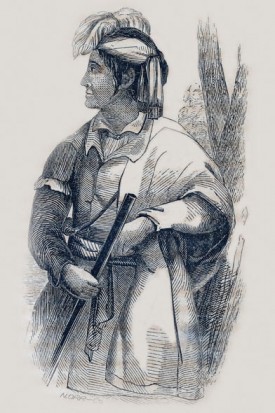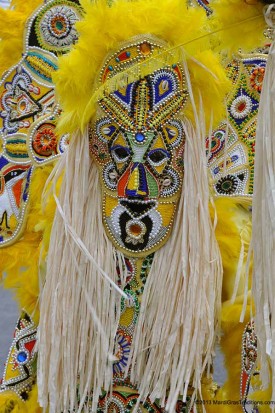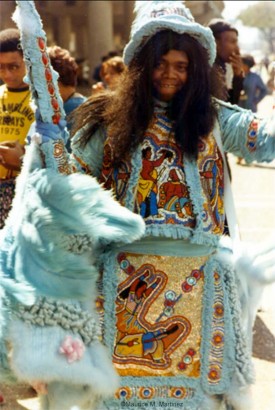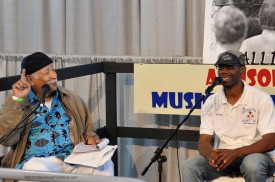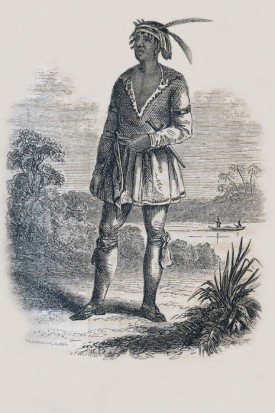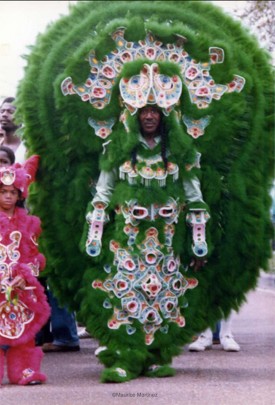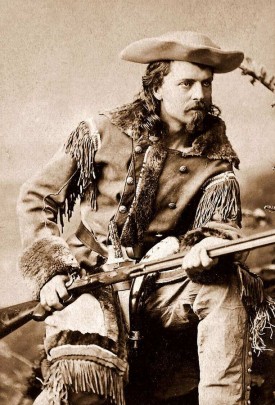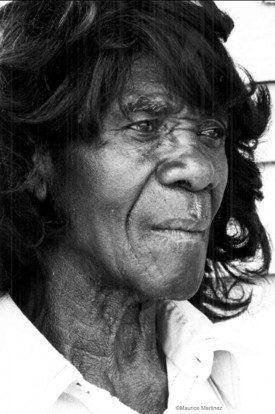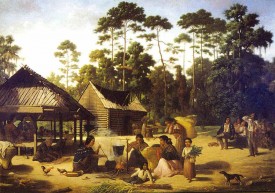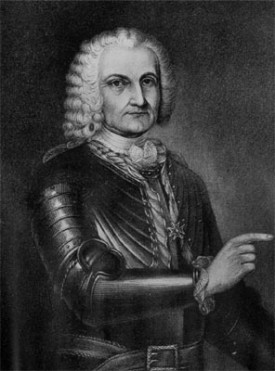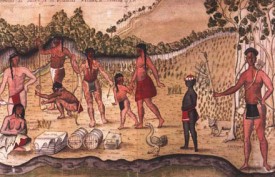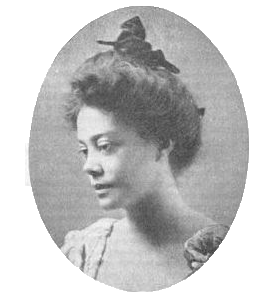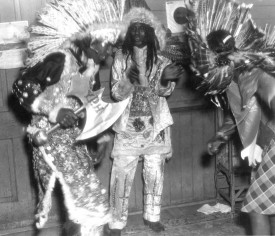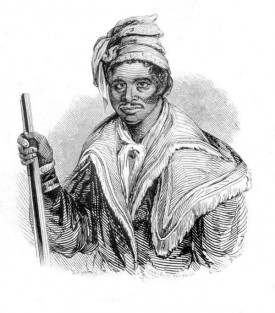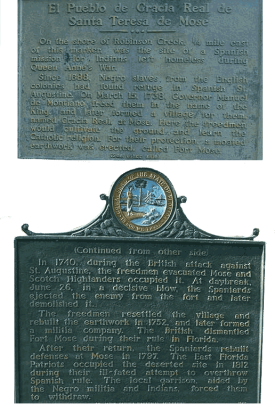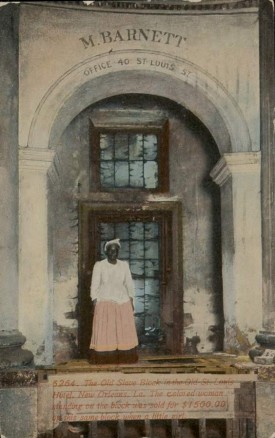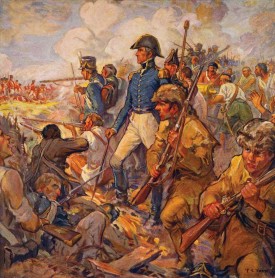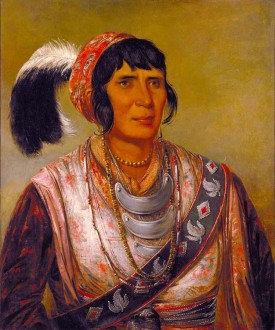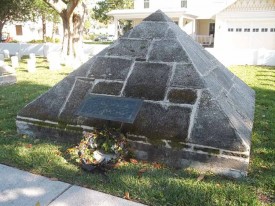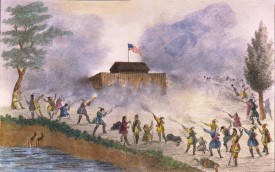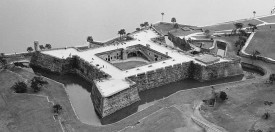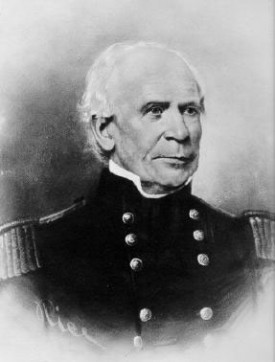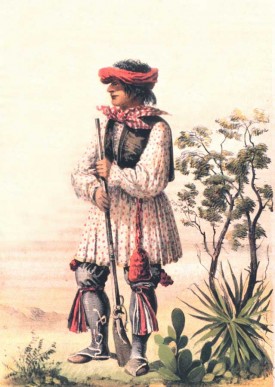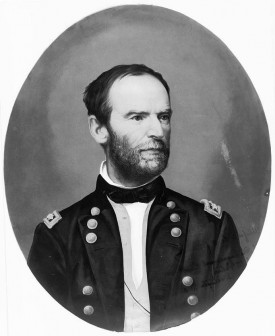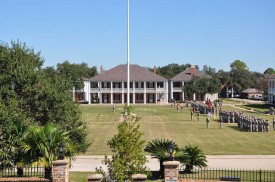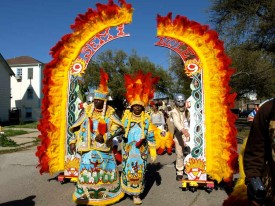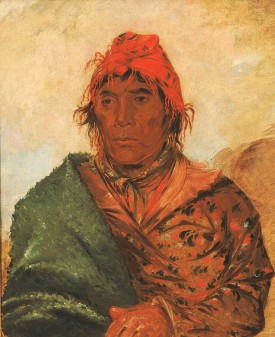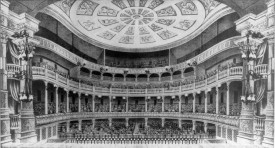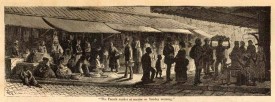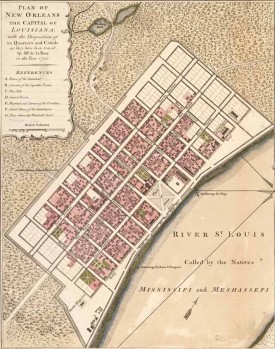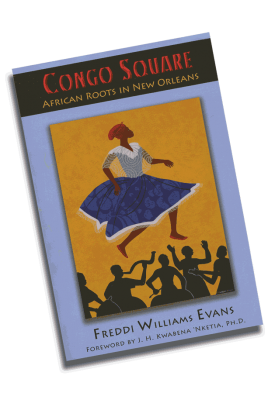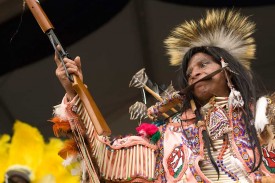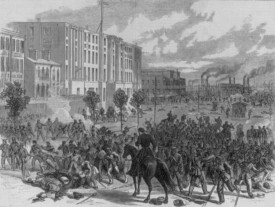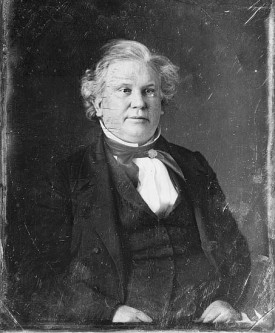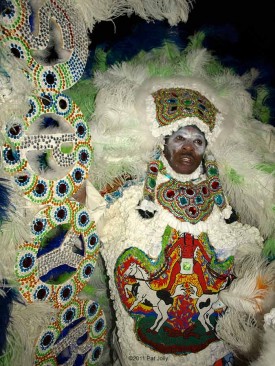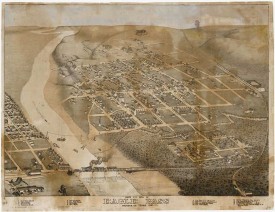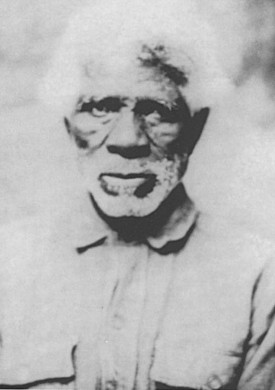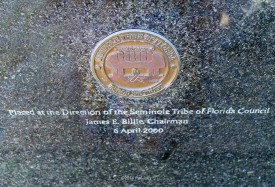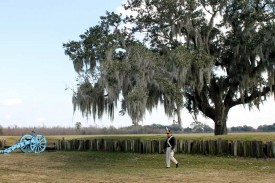The Seminole Indian Coacoochee blazed an extraordinary trail through life, in a dizzying myriad of guises: ferocious warrior, vainglorious showboat, impudent rogue and mercurial firebrand “given to dramatic acts and alcoholic episodes,” as one scholar puts it. A spellbinding orator, visionary diplomat, gifted mystic and charismatic leader who, before the Civil War, engineered an Underground Railroad leading to a multiethnic utopian colony in Mexico. Memorialized in the signature cry of the Mardi Gas Indian Spy Boy — Coochee Malay! — he also may be the key to unsolved mysteries of a “masking” tradition that has become emblazoned on the cultural consciousness of New Orleans and beyond.
Big Chief Wild Cat:
Coacoochee and the dawn of Mardi Gras Indians
By Graham Button
Engraving of Coacoochee sketch attributed to N. Orr
The Mardi Gras Indian expression Coochee Malay memorializes his legacy as an indomitable hero who not only fiercely resisted removal but welcomed runaway slaves, championed the cause of black tribesmen and made possible an Underground Railroad leading to the Black Seminole colony in Mexico.
Image courtesy of the Western History Collections, University of Oklahoma)
In a scene from the documentary film The Black Indians of New Orleans, the rooftops of the city’s 10th Ward are silhouetted by the orange break of dawn, as dogs bark and screen doors open and close. Spy Boy Nat, of the White Eagles Mardi Gras Indian tribe, emerges from a humble doorway as if from chrysalis — in full yellow bloom, radiating ebullience.
“I’m the Spy BOY,” he hollers. “I’m the spy boy that morning. Spy Boy Coochee Malay, all in stones. I’m the Spy BOY!”
He turns to the camera and, flashing a triumphant smile, sashays with his arms extended to reveal the full magnificence of his regalia — a multi-layered array of plumage, beadwork and faceted crystals (“stones,” in the parlance of Mardi Gras Indians). “Cuffs” hang from his arms like gaudily trimmed draperies, and his encoded outbursts — an odd-sounding, creolized vernacular handed down through generations of oral tradition — hint at the alluring mysteries of his culture.
“Spy Boy hauling apple. Ah-chee mali baum-baum…,” he proclaims. “Let the sun shine! Let the sun shine that morning!”
When Black Indians was released in 1976, its subjects still constituted a secret society. Parading on neighborhood back streets, they showed little interest in sharing their traditions with the outside world, and attracted only a handful of admirers from beyond the predominantly black, working-class communities that had sustained the culture as a living, and continually evolving, art form since the 1800s. Doors slammed shut on perceived “hustlers” seeking interviews and access for documentary purposes. Practically any “outsider” angling for an “insider” perspective was, by default, suspect.
By the late 1970s, even after gaining some notoriety through commercial recordings of their music and appearances at the New Orleans Jazz & Heritage Festival, Mardi Gras Indians were, at best, a curiosity in the eyes of the local tourism and media establishment. Those who “masked” Indian certainly didn’t seek validation from such quarters, and images of their pageantry and sartorial brilliance simply didn’t figure into marketing campaigns celebrating the city’s heritage.
From back streets to bright lights
But what was once a strictly underground phenomenon has, alas, gone mainstream. As Mardi Gras Indians have evolved from an unruly fringe element harassed by police into celebrated icons, their music and folkways have become emblazoned on the cultural consciousness of New Orleans and beyond. Their costumes or “suits” are now featured in prestigious art exhibitions, while the HBO series Treme, in which Mardi Gras Indians figured prominently, brought the culture to a mass audience. The tribes or “gangs” are now seen as emblematic of New Orleans’s unique identity — a major draw for “cultural heritage” tourists and a fertile subject for a growing body of literature. They attract swarms of photographers, receive prominent media coverage and have been featured in a parade of documentary productions — notably, Always for Pleasure, Cutting Loose, All on a Mardi Gras Day, Tootie’s Last Suit and Bury the Hatchet.
Also joining in salute: The National Endowment for the Arts, which in 1987 awarded the late Allison “Tootie” Montana of the Yellow Pocahontas a National Heritage Fellowship. The late Theodore Emile “Bo” Dollis of the Wild Magnolias received the award, considered the nation’s top honor in folk and traditional arts, in 2011.
Victor Harris, chief of the Mandingo Warriors, a k a Fi Yi Yi, on Carnival Day 2013
What was once a strictly underground tradition, more or less ignored by the New Orleans tourism establishment, is now a recognized as a vital living art form — attracting the interest of museum curators, TV producers and documentary filmmakers.
Photo ©MardiGrasTraditions.com
Some Indians, meanwhile, have taken to performing for conventioneers and busking for tips in the French Quarter. They’ve even appeared in television advertisements for a regional supermarket chain and an enterprising local lawyer.
Although these developments have prompted concern about the demystification and commercialization of the culture, there is consolation in continuity. For there’s no denying that the Indians still have the “fiya,” earning props not only through artistic skill and performance ability — singing, dancing and mastery of the protocols and dramaturgy of “playing Indian” — but also by serving as mentors and community role models. And the competitive aspects of their art and revelry — the never-ending quest to design and show-off the “prettiest” suit — ensure plenty of dynamism. Sartorial innovation commands respect, and there’s no end to the creativity that goes into making a suit that illuminates a theme or tells a compelling “story.” (Interpretations of historical personages and events, as well as commentary on contemporary culture and current affairs, are mainstays of the craft.)
So, regardless of their newfound celebrity, Mardi Gras Indians remain a thoroughly arresting spectacle. And despite all of the concerted efforts to explain their origins, decode their utterances and song lyrics, and dissect the “meaning” of their customs, there are still unsolved mysteries to ponder. Which brings us back to Coochee Malay (pronounced Mah-lay) and Spy Boy Nat, a k a The Coochee Malay Man, in the groundbreaking film The Black Indians of New Orleans.
A coded expression referencing a conduit for escape
Coochee Malay is the signature cry of the Mardi Gras Indian Spy Boy, whose tribal function is to serve as the eyes of the Big Chief. Usually stationed several blocks ahead of the chief, his job is to scout out or “spy” other Mardi Gras Indian tribes in the vicinity, then signal the Flag Boy or other intermediary, who in turn relays the information to the Big Chief. The chief then decides whether to meet the espied tribe or proceed in another direction, to search for other Indians. Since much of the fun of being a Mardi Gras Indian comes from flaunting one’s regalia and engaging with other tribes, in ritualized confrontations known as “challenges,” a savvy Spy Boy must possess a sort of sixth sense when it comes to knowing where to locate other Indians. An Indian assuming this position or role is, in the argot of the street, said to be “runnin’ spy.”
Black Indians doesn’t attempt to decipher Coochee Malay or explain why the phrase is associated with the Spy Boy. But the auteur behind the film, Maurice Martinez, enlightened an audience at the 2010 Jazz & Heritage Festival, while moderating a discussion with Big Chief Romeo Bougere and members of his Ninth Ward Hunters tribe of Mardi Gras Indians.
Nathan “Spy Boy Nat” Williams of the White Eagles Mardi Gras Indians
The “Coochee Malay Man” played a starring role in the groundbreaking 1976 film The Black Indians of New Orleans, which offered a revealing glimpse into what was then a secret society.
Photo ©Maurice Martinez
Coochee Malay is commonly understood to mean “Here I am!” It’s a shout that Spy Boys — and sometimes their tribal cohorts — use to announce one’s presence and command attention, as in “Spy Boy, Coochee Malay!” Or a Spy Boy might announce, “Big Chief, Coochee Malay!” as in “Here’s the chief!” or “Make way for the chief!”
Prefacing his interpretation, Martinez (pronounced Mar-tin-ez) offered a provocative assertion: that the story of Harriet Tubman’s Underground Railroad, as taught in classrooms across America, is “a distraction.” That, in fact, there were other pathways to freedom that were truly “underground,” in the sense that they were purposely never intended to become part of the mainstream narrative about slavery. A key player in the “real” Underground Railroad, Martinez informed his Jazz Fest audience: the Seminole Indian chief Coacoochee, also known as Wild Cat.
A Creole from the New Orleans’s Seventh Ward who has delved deeply into the peculiarities of Creole and Mardi Gras Indian locutions, Martinez noted that “we” — meaning Creoles and New Orleanians generally — have a tendency to shorten words by dropping syllables. Hence, “Coacoochee” (pronounced Co-AH-coochee or Go-AH-coochee) becomes “Coochee.”
“So when Coochee came along,” Martinez related, “he say, ‘Follow me to freedom; get out of this wretched existence you in, in this racist South.’ And of course, in Creole you don’t say Je vais — ‘I go’ — you say, ‘Me go.’ So it’s Moi aller, not Je vais. When you say it fast enough, it’s Malay.” Coochee Malay became, in other words, a coded expression of those who saw Coacoochee as a conduit for escape. Loose translation: “Coochee, here I am! Me go with you to freedom.”
To Indian Territory via New Orleans
There is little doubt that slaves and free people of color in 19th century New Orleans would have found much to admire in Coacoochee. By the time he first set foot in the city, in 1841, he’d already acquired a formidable reputation as a warrior and resistance leader in the Second Seminole War in Florida, battling U.S. efforts to remove his people west to Indian Territory. Black Seminoles — comprised mostly of runaway slaves and their descendants — figured prominently in the first phase of that war, fighting in alliance with native Seminoles.
Maruice Martinez interviewing Big Chief Markeith Tero of the Trouble Nation Mardi Gras Indians at the 2013 New Orleans Jazz & Heritage Festival
A keen interpreter of Creole and backstreet New Orleans vernacular, he decoded the meaning of “Coochee Malay” and revealed the “sacred” connection between Coacoochee and the Mardi Gras Indians.
Photo ©MardiGrasTraditions.com
They became known as Black Seminoles or Seminole Negroes not so much because they were of mixed blood — intermarriage with members of the Seminole tribe was, in fact, infrequent — but rather because they were of African descent and had become closely associated with the Seminoles in Florida — a haven for blacks fleeing racism and bondage in Georgia and Carolina.
Between 1836 and 1842, according to The Encyclopedia of American Indian Removal (edited by Daniel F. Littlefield, Jr. and James W. Parins), an estimated 4,200 Seminoles and Black Seminoles capitulated to the U.S. government’s removal demands. New Orleans served as a way station on their journey from Florida to their new home in the West. Most of the Black Seminoles agreed to surrender on the promise of receiving protection and freedom in Indian Territory, but they would up having their hopes dashed as the slave trade encroached on their existence.
Coacoochee shared their sense of indignation. The land and climate in Indian Territory were a poor substitute for what the Seminoles had left behind in Florida, and U.S. government overseers demanded that Coacoochee and his people not only live in close proximity to their traditional enemies, the Muscogees (Creeks), but also submit to their laws, which included harsh slave codes.
“Gopher John” (a k a John Horse) illustration by N. Orr
The trajectory of his colorful life, beginning in Florida and ending in Mexico — with stops along the way in Indian Territory, Washington, D.C. and New Orleans — intersected with Coacoochee’s in ways that were destined to shape history and transform him into a cultural icon.
Image courtesy of the Western History Collections, University of Oklahoma
Making a pact with his old friend and comrade from Florida, John Cowaya, a k a John Horse, leader of the Black Seminoles, the restless chief decided to bust a move. In 1849, Coacoochee led a contingent of Seminoles and black tribesmen on an epic journey to Mexico, where slavery had been outlawed and the government was welcoming immigrants willing to serve in a military capacity. Once established, the Black Seminole colony south of the border became a magnet for runaways from slave states, just as the Seminole settlements in Florida had become a refuge for fleeing slaves decades earlier. Eventually, most of the Black Seminoles in Mexico relocated to Texas. There they gained fame serving as scouts for the U.S. Army, helping to secure the borderlands against raids from hostile tribes.
Back in New Orleans, the retained memory of Coacoochee and the Black Seminoles who served as scouts — four of whom won the coveted Medal of Honor — came together in the persona of the Mardi Gras Indian scout or Spy Boy. Coochee Malay became the Spy Boy’s shout-out to Coacoochee and his legacy as an indomitable hero who championed the cause of black tribesmen and made possible the Underground Railroad leading to the Black Seminole colony in Mexico.
Overlooked history concealing a hidden mystery
In literature and documentation touching on the origins of Mardi Gras Indians, one encounters many generalities about how Native Americans provided refuge to runaway slaves, intermarried with people of color and shared with them the common experience of subjugation. Slaves and their descendants identified with tribes and chiefs that fiercely resisted colonial domination. Famous Indian warriors and their exploits are, in fact, depicted on the beadwork “patches” that adorn some Mardi Gras Indian suits today. And the familiar Mardi Gras Indian lyric “Won’t bow down/on that dirty ground” speaks to the shared struggle of Indians and blacks to maintain dignity in the face of oppression.
The legendary “Chief of Chiefs,” Allison “Tootie” Montana
An exceptionally dedicated practitioner whose suits continually raised the bar in terms of design and craftsmanship, the late chief of the Yellow Pocahontas also is revered for his decisive influence in steering competition between Mardi Gras Indians tribes away from physical confrontation and toward aesthetics, as well as for speaking out about the contentious relations between Mardi Gras Indians and the New Orleans police force.
Photo ©Maurice Martinez
African and Native American peoples also had a spiritual kinship based on the conviction that, as bell hooks observes in her essay “Black Indians,” “the dead stay among us so that we will not forget.” Ritual and performance in both cultures reflected a belief system in which the living worshiped and celebrated among the spirits of their ancestors. In this sense, Mardi Gras Indians see themselves as caretakers of memory, and their ritual can be interpreted not as mimicry but as a reenactment of historical consciousness.
But for all the pontificating about these common affinities, few if any concrete examples have surfaced that explicitly connect the origins of the Mardi Gas Indians to specific instances of affiliation between runaways and Amerindians. The derivation of Coochee Malay, and the extraordinary story of Coacoochee and the Black Seminoles, can thus been seen as a key missing link to understanding not only the genesis of the Spy Boy but the entire Mardi Gras Indian tradition.
As far as written history, the Seminole connection to Mardi Gras Indians has been almost completely overlooked. Journalists and historians often cite Becate Batiste as the first chief to preside over a tribe of Mardi Gras Indians, the Creole Wild West, in the 1880s. The original source for these accounts, according to Martinez, was Becate’s great nephew, the legendary “Chief of Chiefs,” Tootie Montana, who died unforgettably in 2005 — collapsing at a podium while passionately addressing the New Orleans City Council about the contentious relations between Mardi Gras Indians and police.
Tootie’s knowledge of Becate had been passed down to him through oral tradition, and this helps explain why so little documented history about early Mardi Gras Indians exists. Interviewing participants for documentary purposes was unheard of until New Orleans poet and historian Marcus Christian gathered material during the 1930s for a study of African Americans in Louisiana. The Works Progress Administration’s Louisiana Writers’ Project in the 1940s also produced noteworthy glimpses of the culture, but hardly opened the floodgates. Indeed, when Martinez interviewed Tootie Montana and Gerald “Jake” Millon, chief of the White Eagles, in 1975 for his documentary film, it was, among the cognoscenti, considered a coup.
The Buffalo Bill theory
The mystery surrounding people of color in New Orleans taking to the streets as Indians has prompted much speculation. Might the first Mardi Gras Indians have been inspired by the Buffalo Bill Wild West Show, which spent several months in New Orleans while the city hosted the 1884-1885 World’s Industrial and Cotton Centennial Exposition? The show, as described by historian Daniel H. Usner Jr., featured real Plains Indians attacking a stagecoach, high-stepping to a war dance and hunting a buffalo. If it was Becate who coined the name the Creole Wild West, was he tipping his feathered headdress to Buffalo Bill Cody’s “Wild West” extravaganza?
William “Buffalo Bill” Cody
While some observers have maintained that his “Wild West” extravaganza, which wintered in New Orleans in 1884-1885, inspired the Mardi Gras Indian tradition, oral history and the legacy of Coacoochee suggest otherwise.
Photo by Sarony (public domain via Wikimedia Commons)
The Buffalo Bill theory of the origin of Mardi Gras Indians — advanced most notably by the late photographer Michael P. Smith — has been the subject of considerable debate. In his book Mardi Gras Indians, Smith points out that the cotton expo included “appearances by American Plains Indians, Mayan Indians and other indigenous peoples, all in native costume.”
Mardi Gras 1885 was “extraordinary,” he writes. “On the streets were large numbers of international visitors connected with the Exposition, several Central American Indian groups, and some fifty to sixty Plains Indians from the Wild West Show, including four chiefs, all of whom were likely on the street in their native dress…. The oral history of present-day Mardi Gras Indian gangs begins at just about that time.”
Martinez, for his part, doesn’t buy the Buffalo Bill theory. No contemporaneous written account has surfaced linking the Creole Wild West, or Mardi Gras Indians generally, to the Buffalo Bill show. More importantly, says Martinez, oral history does not lend support to the theory.
It took years for Martinez to network his way into the Mardi Gras Indian community and gain enough trust to have access to the oral history, which was never intended for the enlightenment of people from outside the culture. His Black Indians documentary enhanced Martinez’s credibility and afforded him opportunities to connect with additional informants, including one old-timer who masked Indian well before Tootie Montana came on the scene. Martinez’s sources also included so-called “Hawks” — elders who didn’t mask but steadfastly preserved institutional knowledge by committing to memory details of suits from years past.
Not one of Martinez’s informers ever mentioned the Buffalo Bill show. At least two of them did, however, acknowledge Coacoochee.
The guarded truth of a sacred connection
After completing his film, Martinez exhibited it on the festival circuit and at old-folks homes in New Orleans. “On one occasion,” he recalled in an email, “an elder by the name of Eddie Richardson came up to me with a big smile, and we talked for hours.” Turned out that Richardson, who was born in 1903, masked Indian beginning around 1915, eventually becoming chief of his own tribe, the One Eleven. Martinez asked him about the meaning of Mardi Gras Indian song lyrics, chants and expressions. “He told me, in a tone of secrecy, that Coochee Malay (the outcry of a Spy Boy) went back to Coacoochee, who took slaves to freedom.”
Danny Lambert, legendary chief of the Wild Squatoolas
One of Martinez’s old-time Indian informants who spoke of Coacoochee with guarded reverence, acknowledging the Seminole chief’s heroic status in Mardi Gras Indian lore.
Photo ©Maurice Martinez
Further verification came from another elderly former chief, Danny Lambert, who presided like a general over an enormous tribe, the Wild Squatoolas, whose number could approach, if not at times exceed, 100. Martinez says that whenever Coacoochee came up in conversations and interviews with his informants, they spoke guardedly, as if “they almost didn’t want to go there…. I felt that it was something sacred, not to be revealed.”
In his email, Martinez confessed to having reservations about possibly breaching a “sacred tradition” by divulging the connection between the legendary Seminole chief, who succumbed to smallpox in Mexico in 1857, and the Mardi Gras Indians. But the educator in Martinez — he is a professor emeritus at the University of North Carolina Wilmington’s Watson College of Education — got the better of him. Enough time has passed, he writes, and “I feel the world should know why these guarded truths were kept so secret. It was an act of preservation,” necessary for “survival in an oppressive colonial society.”
The Mardi Gras Indian phenomenon can be understood as a reaction to the tribulations of being marginalized in such a society. In New Orleans, a slave-trading mecca, adopting the Indian persona was simultaneously a symbolic expression of ritual freedom and resistance; an act of homage to Indians who gave sanctuary to runaways in colonial times; and a means of channeling and preserving African forms of song and dance.
To see how Coacoochee fits into this picture, however, one must pull on threads that run through the broader fabric of North American colonization. For his story, and the case for the Black Seminoles and he as lodestars for Mardi Gras Indians, is woven into the history and politics of slavery and Indian removal, and extends to the enforcement of color lines governing participation in pre-Lenten festivities (Carnival) and society generally. The overall geographic arc ranges from the southeast through Louisiana to the borderlands of Mexico, bringing to mind the words of Ralph Ellison in Going to the Territory:
“For the slaves had learned through the repetition of group experience that freedom was to be attained through geographical movement, and that freedom required one to risk his life against the unknown. [Geography] has performed the role of fate, but it is important to remember that it is not geography alone which determines that quality of life and culture. These depend on the courage and personal culture of the individuals who make their homes in any given locality.”
By this reckoning, black and Indian cultural connections during the colonial era are key to understanding how Mardi Gras Indians came to exist in New Orleans. For colonialism and its byproduct — slavery — made it inevitable that these two cultures would intersect in ways that would shape history.
Indians and Africans in Bienville’s Louisiana
Choctaw Village near the Chefuncte by François Bernard, 1869
As allies of the French, who relied on Indians for survival in the early days of the Louisiana colony, the Choctaw assumed a position economic and political advantage among tribes engaged in regional trade in the Lower Mississippi Valley.
Indians figured more prominently than Africans in the early development of the Louisiana colony. In 1718, Jean-Baptiste Le Moyne, Sieur d’Bienville, a French-Canadian explorer acting on behalf of the French Crown, established New Orleans as a permanent settlement. Bienville chose a site surrounded by a giant crescent bend in the Mississippi, after being led there by Indians via a portage from Lake Pontchartrain.
In the early days of the Louisiana colony under the governorship of Bienville, enslaved Indians far outnumbered enslaved Africans. But the general recalcitrance of Indians, and their familiarity with terrain and local tribes, made it hard to keep them in bondage. Frustrated by Indian runaways, Bienville (for the most part unsuccessfully) championed the idea of sending Indian slaves to the West Indies in exchange for African slaves. The first ships bringing enslaved Africans to Louisiana arrived in 1719.
In his book Indians, Settlers, and Slaves in a Frontier Exchange Economy: The Lower Mississippi Valley before 1783, Usner points out that because “Louisiana remained a deprived and isolated satellite of the French empire,” settlers and soldiers came to depend heavily upon Indian villages “for both subsistence and security.”
“Many colonists,” Usner notes, “owned their survival to Indian villagers who provided food during hard times.”
During the eighteenth century, native peoples were a familiar sight in New Orleans. As Usner observes in another study, American Indians in the Lower Mississippi Valley: Social and Economic Histories, “The capital of colonial Louisiana was home to Indian slaves captured in warfare and host to Indian diplomats from neighboring tribes. Many local villages also produced valuable trade items, especially food, for the New Orleans market and thereby established enduring ties to the colonial town.”
J.C. Buttre portrait of Jean Baptiste Le Moyne, Sieur d’Bienville
Under his governorship, as slave labor became increasingly important to Louisiana’s colonial economy, fraternization between Africans and Indians was regarded as a threat requiring suppression.
Usner’s scholarship also highlights the varying dimensions of Indian interaction with people of African descent in the Lower Mississippi Valley. Slaves, free people of color and Indians participated in what he terms a “frontier exchange economy,” which evolved into “a strategy of survival” and a framework for cross-cultural relations. But inter-colonial rivalry between the French and British for influence in the Lower Mississippi Valley, coupled with the rise of the plantation economy, destabilized this network of relationships and led to tougher laws governing interaction among slaves, settlers and Indians. The colonial divide-and-rule agenda, according to Usner, disrupted tribal relations, heightened ethnic tensions and circumvented traditional roles.
Africans, for example, found themselves working for the French as enslaved soldiers in wars against hostile Indians, sometimes earning their freedom by doing so and becoming a permanent part of the Louisiana militia force. With encouragement from colonists, Indians enslaved members of enemy tribes. Some Indians became bounty hunters for escaped African slaves, who sometimes found refuge among sympathetic local tribes.
In a pattern repeated in Florida and along the border between Texas and Mexico, “intercultural collusion” (Usner’s term) between Indians and Africans aroused much trepidation among colonial officials, white settlers and slaveholders. Permitting such collusion to go unchecked was, for Bienville, tantamount to encouraging rebellion.
Wanted dead or alive:
“seditious” African among rebellious Natchez
Among the tribes of the Lower Mississippi Valley, the Nachez posed the most serious threat to the French colonial enterprise. A dispute over a debt that led to the killing of a Nachez villager in 1722, at the hands of a guard at Fort Rosalie, escalated into a crisis following a retaliatory raid on a plantation. After suffering counterattacks on their villages, the Nachez negotiated a peace with colonial authorities, who demanded, in addition to the scalps of several insurrectionary warriors, that the tribe “bring in dead or alive a negro who has taken refuge among them for a long time and makes them seditious speeches against the French nation and who has followed them on occasions against our Indian allies.”
Drawing of the Savages of Several Nations, New Orleans, 1735, by Alexandre de Batz
The child of African descent in the right foreground prefigures the “intercultural collusion” later manifested in the Mardi Gras Indian tradition, while the woman kneeling on the left reveals that Indians shared with Africans the experience of subjugation under colonial rule. Next to her de Batz wrote “Renard Sauvagesse Esclave” or “Fox Indian (Female) Slave.”
The Choctaw — having assumed a position economic and political advantage among tribes engaged in regional colonial trade — were the primary Indian allies of the French. Together they mounted a retaliatory campaign against the Nachez when hostilities, triggered by the prospect of further encroachment on Nachez lands, flared anew in 1729.
In a carefully planned ambush of colonial outposts on November 28, according to Usner, Nachez rebels killed 237 men, women and children. They also captured 300 black slaves in addition to some 50 white women and children.
“Over the months of conflict that followed…,” Usner writes, “colonial authorities suppressed collaboration…between Indians and slaves with extreme force…. As feared by slaveowners, many of the African American slaves taken from the upriver concessions during [the attack] did serve as allies, more than as hostages, of the Nachez rebels.”
Joined by some 500 Choctaw warriors, the French practically obliterated the Nachez. Three black slaves “who had taken the most active part in behalf of the Nachez,” reported Father Mathurin le Petit, a Jesuit missionary, were given to the Choctaws and “burned alive with a degree of cruelty which has inspired all the Negroes with a new horror of the Savages, but which will have a beneficial effect in securing the safety of the Colony.” (Surviving Nachez warriors would, however, continue to wage sporadic guerilla warfare against the French along the banks of the Mississippi.)
Well before Coacoochee arrived on the scene, New Orleans had established itself as a multicultural entrepôt with Dionysian propensities, largely aloof from the mainstream of American Anglo-Protestant culture. It became, simultaneously, a center of the slave trade and, thanks in part to its Latin-Catholic heritage, a socially permissive place where the bloodlines of different races mixed and slaves were allowed to assemble on Sundays and partake in traditional African customs.
Alice Dunbar-Nelson
Echoing the recollections of Jelly Roll Morton, her fictional account makes clear that before turn of the 20th century, Mardi Gras Indians presented an arresting spectacle that fascinated curious onlookers in much the same way the African-derived drum-and-dance festivities had done generations earlier at Congo Square.
Photographer unknown (public domain via Wikimedia Commons)
But if a remarkable ethnic diversity made New Orleans an exotic and intriguing society, it also bred fears and hostilities. Amidst racial tensions and periodic prohibitions against wearing masks — initially applied to slaves and free people of color — Mardi Gras — a European tradition transplanted to Louisiana by French colonizers — offered a temporary escape from rigidly defined roles and boundaries. On this day — the culmination of the Carnival season of merriment and make-believe before the penitential devotions of Lent — subversions of the normal order were de riguer. Away from pageantry staged by the dominant white culture, men of African and mixed-race descent began transforming themselves into free-spirited warriors “to disguise their own defiance and prowess behind an acceptable mask of wild Indian behavior,” as Usner puts it.
There was no mistaking the intensity of demeanor exhibited by the maskers. Usner, whose research was funded in part by the Historic New Orleans Collection, cites Alice Dunbar-Nelson’s short story “A Carnival Jangle.” Published in 1895, it depicts a Mardi Gras gathering in Washington Square — downriver from the French Quarter, in Faubourg Marigny — where blacks performed “a perfect Indian dance.” Spectators filled the square “to watch these mimic Redmen, they seemed so fierce and earnest.”
As a child growing up around the turn of the 20th century, Jelly Roll Morton thought Mardi Gras Indians were real Indians. In reminiscences with folklorist Alan Lomax, the Creole pianist and jazz composer described the Indians as “one biggest feats that happened in Mardi Gras. Even at the parades with floats and costumes that cost millions, why, if the folks heard the sign of the Indians
Ungai-ah!
Ungai-ha!
— that big parade wouldn’t have anybody there: the crowd would flock to see the Indians….
“They would dance and sing and go on just like regular Indians, because they had the idea they wanted to act just like the old Indians did in years gone by and so they lived true to the traditions of the Indian style,” Morton, who himself claimed to have masked as a Spy Boy, explained to Lomax.
The mythology of “masking Indian”
If there were always elements of theatricality and play to “masking Indian,” underlying the “performance” was a deeper meaning having more to do with channeling warrior/ancestral spirits and paying ritual homage than mere imitation or parody, as implied by the Buffalo Bill theory of Mardi Gras Indians.
Members of the Yellow Pocahontas Mardi Gras Indians, 1942
Over time, the headdresses reminiscent of Plains Indians regalia and typically made from turkey feathers would give way to more elaborate “crowns” featuring colorful profusions of dyed ostrich plumes and marabou (stork) feathers procured at considerable expense from specialty suppliers.
Unknown Works Progress Administration photographer (public domain via Wikimedia Commons)
The late Robert Nathaniel Lee, a k a Big Chief Robbe (pronounced Ro-BEE), first put on an Indian suit in 1929 and over the course of thirty-three years of masking served as chief of four different tribes, including the Creole Wild West and the White Eagles. “It all started when young men ran away from their masters and lived with the Indians and as Indians,” he recalled in a 1996 interview with Lynne Jensen of the New Orleans Times-Picayune. “After slavery, they began to spread out, but they never forgot the tribes they lived with….
“At first,” he went on to note, “the Native Americans thought we were making fun of them. But they found out better.”
Plains Indians are often cited as a source of inspiration for Mardi Gras Indians. Sporting feathers and a beaded band across the forehead, the headresses or “crowns” of Mardi Gras Indians photographed in early decades of the 20th century resembled the “war bonnets” of Plains Indians. The decorated aprons characteristic of Mardi Gras Indian suits also may have owed a stylistic debt to the Plains tribes.
But no one really knows how the earliest Mardi Gras Indians adorned themselves, or whether the Plains Indians in the Buffalo Bill show influenced the regalia of New Orleanians of color who masked Indian in the late 1800s. What is clear is that Plains Indians conformed to the popular image of Indians native to areas west of the Mississippi River as “wild” and warlike, and that this “Wild West” stereotype — applied to tribes like the Sioux, Apache and Comanche, and reinforced by the Buffalo Bill show — would likely have had a certain inherent appeal to Mardi Gras Indians including, possibly, members of the Creole Wild West.
N. Orr’s engraving of Black Seminole Chief Abraham, published in 1848 in The Origin, Progress, and Conclusion of the Florida War by John T. Sprague
He made a name for himself as interpreter for, and advisor to, the Native American Seminole leadership.
The Seminoles, by comparison, have been largely overlooked as an influence on Mardi Gras Indians. This is surprising considering that, in the 1830s and 1840s, New Orleans served as a transshipment point for thousands of Seminoles during their removal to Indian Territory in the West. Their reputation — as fearsome warriors who put the hurt on soldiers and volunteer militiamen in Florida — preceded them, and their public presence in the Crescent City caused something of a sensation, attracting considerable notice in local newspapers. Their flamboyant regalia turned heads, moreover, as did the fact that the blacks among them weren’t submissive. Some, in fact, held positions of tribal influence — conveyed not only by their dress, commanding bearing and physical stature, but also by their roles as interpreters and advisors to Seminole headmen.
But most importantly, no Amerindian tribe more fully embodies the mythology of Mardi Gras Indians. For Seminoles not only symbolized fierce resistance to white domination but also provided refuge to runaway slaves en masse. This African-Indian collusion greatly antagonized those with a vested interest in the plantation economy of the South — and helped ignite what became the most costly “Indian” war ever waged by the United States.
Origins of the Seminole Wars
The Seminoles and Black Seminoles were, indeed, slaveholders’ worst nightmare come true. For if French colonizers in Mississippi and Louisiana had dreaded the prospect of runaways entering into military alliance with Indians, Spanish authorities in Florida condoned if not encouraged it as a means of undermining British and American colonial ambitions.
Reports by Spanish authorities of blacks arriving in Florida date back as far as 1688, according to Rosalie Schwartz’s monograph Across the Rio to Freedom: U.S. Negroes in Mexico — before the formation of the Seminole Tribe. The Spanish welcomed the immigrants, promising them protection from their British subjugators. “Large-scale slaveholders in their own right, the Spaniards were not necessarily motivated by sympathy for the Negroes enslaved by the British,” notes Schwartz. Rather, amidst an inter-colonial struggle for control of the fur trade and dominion over Indians and territory, the Spanish viewed the new arrivals as prospective military colonists.
Plaque commemorating Fort Mose in St. Johns County, Florida
In 1812, annexationist forces known as the East Florida Patriots, occupying the site during an ill-fated attempt to overthrow Spanish rule, were forced to withdraw after bring confronted by Spaniards “aided by the Negro militia and Indians.”
Photos by Ebyabe (via Wikimedia Commons)
In 1738, writes Schwartz, “liberty was granted to Negro fugitives who had been held as slaves by Spanish citizens of St. Augustine, despite the angry protests of the owners.” This resulted in the establishment of a settlement for the fugitives near St. Augustine. The first free black community in North America, Gracia Real de Santa Teresa de Mosé boasted a militia occupying a moated earthworks called Fort Mose. Word of the settlement, and of the liberties granted under Spanish rule — blacks could own arms and property, choose their own leaders and travel at will — filtered back to southern British colonies, fueling dreams among the enslaved of escaping to Florida.
Meanwhile, tensions were brewing within the region’s most powerful indigenous confederation — the Muscogees, known to English speakers as the Creek Confederacy. Around 1750, according to Coacoochee’s Bones: A Seminole Saga by Susan Miller, a man named Wakapurchase, a k a Cowkeeper, withdrew from the Muscogee confederacy and moved his people southward into Florida. Other bands followed, motivated by factors such as disaffection with the Muscogee chiefdom, resistance to European influence, and the prospect of available land with abundant hunting and fishing.
Over time, these groups of migrant Muscogees would form a new confederation. They became known as Seminole, which — as Kevin Mulroy points out in his book Freedom on the Border: The Seminole Maroons in Florida, the Indian Territory, Coahuila, and Texas — “appears to have been a corruption of Cimarrón, a Spanish word for runaway or maroon.”
“These Indians were runaways themselves, refugees from war and oppression, exiles in a strange land,” Mulroy observes.
The Spanish welcomed them as a buffer against encroachment by British and, later, American colonists, and encouraged runaways to seek refuge in Seminole villages. By the 1830s, notes Miller, Seminoles owned black slaves and even those who didn’t may have “believed in a racial hierarchy.” Nevertheless, a genuine affection between the races developed as evidenced by the fact that Seminoles refused to sell their slaves to whites or other Indians.
A system of tribal vassalage
Whether blacks were claimed as slaves or regarded in some quarters as potential slaves, the form of slavery practiced by the Seminole was relatively benign. According to Miller, “Seminole slaves often lived in towns with free Africans, where they dressed as Seminoles, farmed and paid a share of their crop to their masters, hunted with guns, and enjoyed great autonomy.” The black and tribal villages dotted the banks of the Suwannee River, in north-central Florida.
“The Seminole-owned Africans were given tools and instructed to build huts of their own, in villages adjacent to but separate from those of the Indians,” writes Jeff Guinn in Our Land Before We Die: The Proud Story of the Seminole Negro. They could own land and livestock, choose their own leaders, and maintain a cultural identity distinct from that of the Seminole. “On a daily basis, they were as free as the Seminole themselves.”
In their relations with blacks, whether free or slave, the Indians may have taken a cue from the Spanish, whose idea of bondage was far less onerous than the system enforced by English and French colonists. Similarly, the harsh slave codes of other slave-owning tribes, notably the Creek and Cherokee, tended to mirror the practices of the British and Americans, with whom they maintained relations. “The Indians’ lenient tribal system of vassalage suited Spanish aims perfectly,” Guinn observes. “The blacks would be part of the Seminole, and the Seminole could help fight Americans if and when it became necessary. By aligning the Indians and Africans, Spain increased its defenses without having the responsibility of providing for the runaways.”
Early 20th century photo postcard showing a dilapidated slave block at what had been the biggest slave market in the South, at the Old St. Louis Hotel in New Orleans
The woman in the photo, according to the caption, “was sold for $1500.00 on this same block when a little girl.”
Those defenses were put to the test beginning around 1811. Along the Florida frontier, antagonists had been staging cross-border raids. Black slaves were forcibly taken from whites as well as from indigenous peoples. Besides encouraging Creek raids on Spanish colonies, settlers in Carolina and Georgia lobbied Washington to annex Spanish territory and return captured runaways to their owners. “Blacks who couldn’t be claimed would be handed off to slavers and sold in the markets of New Orleans and Charleston,” notes Guinn.
Faced with the prospect of re-enslavement, the blacks affiliated with the Seminole showed no restraint against annexationist forces responding to attacks on American plantations in eastern Florida. In alliance with Seminole warriors, they repelled an American attempt to eradicate Seminole and Black Seminole towns on the Alachua Plain.
“The savagery with which the Seminole Negro fought astounded the Americans…,” according to Guinn. “Word of America’s defeat spread to the Southern plantations. It conjured the worst fear among slave owners — armed blacks willing and able to kill whites…. Unless something was done immediately about the Seminole and their black allies, word of their prowess would spread throughout America’s slave community and ‘bring about a revolt of the black population of the United States,’ ” as the leader of the so-called “Patriot” forces wrote in a letter to Secretary of State James Monroe.
Andrew Jackson’s military “glory days”
In the ensuing First Seminole War, Andrew Jackson added to his credentials as a revered field commander. He was already a frontier hero for having led a successful campaign against rebellious Creeks in 1813-1814. The resulting Treaty of Fort Jackson displaced many tribespeople, opening up huge swaths of Alabama and Georgia to Anglo settlement. In 1815, “Old Hickory” made his famous, victorious stand against the British in the Battle of New Orleans — which turned out to be the final battle of the War of 1812 — forever securing his place as one of the city’s most celebrated figures.
His final engagement in the First Seminole War came in 1818, leading an overwhelming force of 1,500 soldiers and almost 2,000 Creek warriors. To buy time for occupants of native and black villages retreating into swamps in advance of the onslaught, two hundred or so Black Seminoles stayed behind to engage Jackson’s forces, at a heavy cost. “Jackson ordered his men to sack and burn the maroon and Indian villages,” Mulroy recounts, “bringing to an end what he later termed ‘this Savage and Negro War. ’ ”
It was largely on account of Jackson’s relentlessness in Florida that, in 1819, Spain ceded to America all of its lands east of the Mississippi in exchange for $5 million and American promises not to interfere with Spanish dominion over Texas. Riding his military triumphs all the way to the White House, Jackson showed no sympathy for indigenous peoples, advocating for the use of whatever means necessary to relocate them west of the Mississippi River. As president, he signed the Indian Removal Act into law on May 28, 1830.
Frederick Coffay Yohn’s Andrew Jackson During the Battle of New Orleans, circa 1922
Following successful military campaigns against Indians in the Lower Mississippi Valley and Florida, his heroic defense of New Orleans against the British solidified his stature as future presidential material, especially among those desirous of seeing frontier lands opened up for white settlement.
Library of Congress, Washington, D.C. ~ (Digital ID cph.3g06222)
The government wasted little time in pressing for the removal of the Seminole to a section of Indian Territory dominated by the Creeks. Leaving behind ancestral burial grounds would be bad enough. But to acquiesce would also mean living with enemy neighbors on land of questionable value. If the Americans had their way, the Seminoles would, in effect, become a subordinate part of the Creek Nation — a bitter prospect for a people wishing to preserve their tribal identity and independence.
And what would become of the Black Seminoles in Indian Territory? Surely the Creek wouldn’t let them own guns and enjoy the kind of autonomy allowed by the Seminole, for doing so would only highlight for Creek-owned slaves the inhumanity of their own position. The specter of harassment and abduction by not only the Creek but also unscrupulous white slave traders, who were prone to making fraudulent claims, loomed large.
Some historians have suggested the black maroons decisively stiffened Seminole resolve to fight against removal. Certain black leaders had in fact gained positions of influence among Seminole chiefs, making themselves more or less indispensable in a diplomatic capacity by virtue of their language skills. (The most capable Black Seminole leader, John Cavallo, could speak Muscogee, English and Spanish. He was known by a variety of names, including John Cowaya (possibly a variant of kaway, an indigenous word for “horse”) and, later, John Horse.)
Seminole chiefs, no doubt, weren’t pleased at the thought of having their blacks taken from them in Indian Territory. But among all the factors weighing against emigration, the most salient consideration for the Seminoles, in Miller’s estimation, was the prospect of leaving behind the spirits of their ancestors.
Oil-on-canvas portrait by George Catlin entitled Os-ce-o-lá, the Black Drink, a Warrior of Great Distinction, 1838
After his death in 1838, he was often depicted as an exemplary “noble savage” who virtuously resisted the inevitable march of “civilization,” whereas his successor as Seminole War Chief, Coacoochee, came across in contemporary narratives as an impudent rogue and “bloodthirsty savage.”
Public domain via Wikimedia Commons
“The graves of a community link the dead forever to the landscape, for the spirits of the deceased remain at or return to the site of the burial,” she asserts in Coacoochee’s Bones. “Seminole graves made sacred the soil of their homeland, and the spirits of the Seminole relatives attended the sacred ceremonies…. Coacoochee would say, ‘the moon brings back the spirits of our warriors, our fathers, wives and children.’ Leaving the family graves meant abandoning the many members of the family who had died.”
Historical distortions and
overdue props for Wild Cat
A Seminole herself, with a Ph.D. in history from the University of Nebraska, Miller writes from an indigenous-centered perspective, arguing that European and Euro-American assumptions “distort the published history of the Seminoles.” So, for example, while “Seminoles remember Coacoochee as a great leader,” she notes, “American historians treat him as a minor and aberrant figure. While ignoring or maligning Coacoochee, Americans have made a sort of cult of his contemporary Asin Yahola” — ‘Osceola’ — perhaps in part because he died in one of their prisons where their writers and portraitists could get at him….”
Coacoochee, according to Miller, was born with a twin sister sometime between 1808 and 1816 at a lake on the Oklawaha River, in east-central Florida. “Coake means bobcat,” she explains, “and chee is a diminutive suffix, and so the name Coacoochee, translated literally, might mean ‘little bobcat’ or something like ‘Bobcat, the Younger.’ ” To Americans, he’d become known as Wild Cat. Mexicans would call him Gato del Monte (Mountain Lion).
Born into the most powerful of Seminole clans, Wind Clan, Coacoochee belonged to an elite lineage. His uncle was Nuppa, the head micco (chief) of the entire Seminole confederation. His father, Emathla (known to Americans as King Philip), was the micco of a major segment of the confederation comprised of towns along the St. Johns River.
As the Second Seminole War approached, many Seminole had been reduced to living on a swampy reservation unfit for agriculture. Although they weren’t in the path of “civilization,” the situation was, nevertheless, becoming untenable. Unable to subsist on U.S. government rations, the Indians were helping themselves to provisions and livestock from white settlements.
With pressure to implement the removal policy building in Washington, the various leaders of the Seminole communities were, as Miller relates, “divided over whether to comply with the invaders’ exorbitant demands or to resist at a cost that might prove to be greater.” Coacoochee’s father was in the militant faction, leading raids on St. Johns River plantations around Christmas 1835.
Dade Massacre monument at the St. Augustine National Cemetery
According to the marker on the tomb, all but two of the 106 men under the command of Major Francis L. Dade died in the ambush, which came just three days after the assassination of a U.S. government liaison to the Seminoles — events that marked the beginning of the Second Seminole War.
Photo by Ebyabe (via Wikimedia Commons)
John Caesar, a black Seminole, had clandestinely spread the word among local slaves that a campaign was imminent, according to Kenneth W. Porter in The Black Seminoles: History of a Freedom-Seeking People. As if on cue, when the rampage began, they “swarmed to the Seminoles by the hundreds, painting their faces to symbolize their new allegiance and participating in the plunder and destruction.” Then on December 28, at Fort King, Arpeka, a k a Sam Jones, assassinated the U.S. government’s liaison to the Seminoles.
“Meanwhile,” relates Mulroy, “fifty miles away, north of the Withlacoochee River near the Great Wahoo Swamp, the black guide Louis Pachecho led a relief column under Major Francis Dade into an ambush of Africans and Seminoles. The allies annihilated the infantry unit, killing Dade and ninety-five of his command, the maroons returning later to mutilate the bodies of the victims. The ‘Dade Massacre,’ as it subsequently came to be known, merely marked the beginning of massive casualties on both sides.”
A “fine-looking fellow” —
and a ferocious antagonist
By 1836, Coacoochee, then a young adult, was taking part in Seminole raids in eastern Florida. It wasn’t long before he acquired a reputation among whites as a terrifying bogeyman who took pleasure in depredations. Miller cites a letter written by an American doctor in September 1837:
“This Coacoochee is a fine looking fellow and one of the most ferocious in the whole nation. Never did I see a savage whose countenance was mark’d with more daring and ferocity. Fearful are the stories of his cruelty. He himself relates stories where he has knocked the brains of children against logs and trees, scalp’d their parents and fir’d [burned] their houses….”
As a young officer who served as an aide-de-camp to top Army commanders in Florida, John T. Sprague came to know Coacoochee personally around 1841, when the warrior-chief was making “friendly” visits to U.S. outposts. After the war, Sprague authored the book The Origin, Progress, and Conclusion of the Florida War, published in 1848. Among his observations about Coacoochee:
Lithograph published in 1837 by T.F. Gray and James entitled Attack of the Seminoles on the Block House
American forces were on the defensive in the early stages of the war, as the Seminoles and their black allies quickly gained a reputation as formidable foes determined to resist removal to Indian Territory in the West.
“War to him was a pastime. He became merry by the excitement, and more vindictive and active by its barbarities, and the inefficiency of the enemy. When being pursued through the deep swamps, he has stood at a distance and laughed at and ridiculed the soldiers floundering with their arms and accoutrements in mud and water. With a few followers who adhered to him for his bold achievements and success in plundering, he ranged through the country, going from one part to the other with a fleetness defying pursuit.”
If their superiority in manpower and armaments left something to be desired against the stealth tactics of the Seminoles and their tenacious black allies, the Americans could at least point to progress in the removal effort. Some elements of the Seminole confederation had decided to cooperate. In 1836, 406 Seminoles under chief Holata left Florida. They crossed the Gulf of Mexico and, in New Orleans, boarded another steamship to take them north. Conditions on the vessels were deadly. By the time the party reached Little Rock, notes Miller, 25 among them had perished.
In Florida, the American commander, Thomas S. Jesup, under intense pressure to expedite removal, decided on a bold démarche. Although the Seminoles and their black allies were united in opposition to a common foe, he realized, their interests weren’t identical. The blacks were, fundamentally, more immediately concerned with avoiding enslavement under strict masters than receiving material provisions and monetary annuities from the white man’s government.
In March 1837, Seminole leaders agreed to a capitulation of the Seminole confederation. Hostilities ceased, and the Indians and blacks began making their way to an emigration camp at Tampa Bay. The Americans were jubilant.
Key provisions of the arrangement related to the Black Seminoles: “Major Gen Jesup, in behalf of the United States, agrees that the Seminoles and their allies, who come in and emigrate West, shall be secure in their lives and property; that their negroes, their bona fide property, shall accompany them to the West…”
Slave owners and traders went ballistic on Jesup for having agreed to allow so many fugitive blacks to escape their clutches. Backpedaling, the general began pressuring Seminole leaders to surrender slaves who’d fled during the war. Florida planters, meanwhile, showed up at the relocation camp looking for runaways.
In June, militants rallied to strike a blow against conciliation with the whites. Coacoochee, Osceola and John Horse organized a raid on the camp, absconding with detainees who were being held as a condition of the truce. As hostilities resumed, American frustration with the cost and progress of the war effort came to a boil. “With power enough to blow up the world, and money, cannon and guns enough to whip the best nation in Europe, we have been baffled in all attempts to conquer a few starving Indians,” huffed the New Orleans Daily Picayune in October 1837.
The Great Escape
With his peace plan in tatters, Jesup became determined to seize the abductors and other Seminole leaders by any means necessary. A surprise raid on an Indian encampment nabbed King Philip. About a month later, in late October 1837, the Americans scored an even bigger haul.
Castillo de San Marcos in St. Augustine
Coacoochee’s Houdini-esque escape from this, the oldest masonry fort in the continental United States (construction began in 1672), reenergized the Seminole resistance at a point when the Americans believed enemy “war spirits” had finally succumbed to defeat.
Public domain via the Historic American Buildings Survey and Wikimedia Commons
While in custody, King Philip had agreed to send out runners with instructions for his son to come in for negotiations. Visiting the U.S. command under a flag of truce, Coacoochee was detained. There are different versions of what happened next. Jesup may have let him go back out to parlay with his comrades about complying with American demands, making it clear that his father would pay a price if he didn’t return.
In any case, a new delegation, which included Osceola and John Horse, came forward for peace talks. Accounts differ about whether Coacoochee was present when, again in violation of a flag of truce, a formidable American force emerged from hiding to surround the delegation’s encampment. The surprised warriors, outgunned and outnumbered, didn’t even try to fight. “Thus was the most notorious treachery of the Second Seminole War carried out,” writes John K. Mahon in History of the Second Seminole War 1835-1842. Jesup could report to his superiors that “nearly all the war spirits of the Nation” were in custody. However, notes Mahon, “[a]ny confidence they [the Seminole headmen] had felt in the word of the white leaders was utterly shattered.”
Coacoochee, Osceola and John Horse found themselves imprisoned in an old St. Augustine fortress, Castillo de San Marcos (called Fort Marion by the Americans), sharing a cell with, among others, King Philip. The only sunlight came from a narrow aperture in one wall, fifteen feet above the floor. Somehow the prisoners, presumably by standing on one another’s shoulders, were able to reach the opening and dislodge one of the metal bars running through it. “Even without the bar,” according to Porter, “the exit was exceedingly small — only about eight inches wide.”
One by one, the determined captives, after fasting for five days while awaiting a moonless night, contorted their way through the opening and along a five- or six-foot passage leading to the exterior of the fort’s wall. It was a long drop down to the deep ditch below, but the escapees were able to lower themselves most of the way by using a rope braided from strips of canvas bags that had served as their bedding. (One end of the rope was tied to the remaining bar in the window.)
“Eventually,” writes Porter, “twenty people stood next to the moat, among them Wild Cat, his two brothers, John Cavallo and two women. They were nearly naked, virtually unarmed, and hurt from being cut by the hard rock. But they were free.”
(Details of the escape came from Coacoochee himself, as related in Sprague’s history. After examining the historical record, Porter found no reason to doubt the chief’s veracity and concluded, in an article for the Florida Historical Quarterly in 1944, that Coacoochee was “not only a great warrior, but also a great storyteller.”)
Not all of the prisoners, alas, made it out. Apparently Osceola was too ill, and King Philip too old, to perform the physical feats required of them. They were transferred to Fort Moultrie on Sullivan’s Island off the coast of South Carolina. Osceola died there while in custody, not long after having sat for a portrait by painter George Catlin. (The official cause of death was tonsillitis complicated by an abscess, although Catlin maintained that, in fact, he had died of a “broken spirit.”) Sent to join the Seminoles in Indian Territory, in 1838, King Philip died on his way from Fort Pike, in Louisiana, to Little Rock.
After his escape, in November 1837, Coacoochee became the military leader of those Seminoles still holding out against removal. “For three more years,” notes Miller, “he and a few of his associates would hold that resistance together.”
He had to do so largely without the military support of the Black Seminoles. Shared experiences, mutual respect and common goals had, by all accounts, made him and John Horse close comrades. They were brothers in arms, having shared dual command in the largest and bloodiest clash of the war — the Battle of Lake Okeechobee on Christmas Day 1837, with John Horse leading the blacks.
General Thomas S. Jesup
Seeking to divide the Seminoles as a military force and expedite an end to the war, he promised John Horse and his black tribesmen emancipation and protection in Indian Territory.
But in early 1838, General Jesup effectively drove a wedge between the Seminoles and their allies. “In direct contradiction to his earlier treaty with the Seminoles,” Mulroy writes, “Jesup began to offer freedom to the blacks if they would separate from the Indians and surrender.” Despite lacking the requisite statutory authority, he promised John Horse and his people — “perhaps four-fifths of whom were either runaways or their descendants and still legally slaves,” notes Mulroy — emancipation and protection in Indian Territory. In theory, not even lenient Seminole chiefs would be able to enforce claims to be their masters.
Jesup’s gambit worked. A steady exodus of black tribesmen began heading west via New Orleans. They were usually accompanied Seminoles who had either been captured or decided to give up the fight against removal.
A “noble savage” mythologized
All the while, newspapers were feasting on the rich bounty of exploits, intrigues, personalities and policy debates generated by the war. As Coacoochee was poised to emerge as the most dramatic Seminole figure in the Florida conflict, writers were busy mythologizing Osceola. His image conformed to the white man’s trope of the “noble savage” who virtuously resisted the inevitable march of “civilization.” “Although the war went relentlessly on to drive his people out of Florida,” Mahon observes, “Osceola became to many Americans a symbol of the patriotic chief fighting for the land he loved.”
Coacoochee’s image, by contrast, could not possibly be distilled in such a neat, tidy package. In contemporaneous American narratives — “hardly any Seminole commentary on Coacoochee exists in print,” Miller notes — he’s seen in a dizzying myriad of guises: charismatic leader, spellbinding orator, visionary diplomat, gifted mystic, ruthless killer, vainglorious showboat, impudent rogue and trickster, and flawed, mercurial firebrand “given to dramatic acts and alcoholic episodes,” as Miller puts it.
His was, in the final analysis, a leader of extraordinary ability. As General Jesup told the secretary of war, “He is decidedly the most talented man I have ever seen among the Seminoles, and should, and no doubt will, be the principal Chief of the Nation….”
Coacoochee initially gained fame as a military antagonist, with his public persona shaped, in large part, by American soldiers’ reports, journals and letters. “A newspaper would run a soldier’s personal letter or a passage from his journal,” Miller explains, “and then another newspaper would reprint it. Thus the news of Coacoochee reached many Americans, and his reputation grew.” Rounding out the picture are firsthand reports of journalists in Florida, New Orleans and beyond.
Physical descriptions of the chief often mention his handsome features and penchant for flamboyant attire. An army surgeon remarked, “Coa-curhee has the countenance of a white man — a perfect Apollo in his figure — dresses very gaudily, and had more than the vanity of a woman.” Sprague, the Seminole War officer and historian, describes him as “well proportioned, with limbs of the most perfect symmetry. His eye is dark, full and expressive, and his countenance extremely youthful and pleasing. His voice is clear and soft, speech fluent, and his gestures rapid and violent. With a mind active and ingenuous, clear and comprehensive, he carried into all his measures, spirit and influence; governing his band in a firm, but politic manner.”
“All white observers conceded his good looks,” notes Mahon, “but some thought him ferocious looking… He was perfectly aware of the impact of his own appearance.”
Dressing to impress
Portrait of Coacoochee’s relative Nogusa Emathla Tustenuggee, a k a Grizzly Bear, from Report on the United States and Mexican Boundary Survey (1857-1859) by William H. Emory
Perhaps the most distinctive feature of Seminole regalia is the turban, often (although not in this particular case) adorned with plumes.
Especially when making visits to U.S. outposts during suspensions of military operations, he liked to present himself with the utmost effect. A young second lieutenant named William Tecumseh Sherman, later to gain fame in the Civil War, recalled, in his memoirs, escorting Coacoochee to Fort Pierce in the spring of 1841. The young officer headed out with eight or ten mounted troops. Coacoochee’s interpreter, Negro Joe, led them to a hammock where the chief and about a dozen of his warriors were chilling out.
“They all seemed to be indifferent, and in no hurry” to take up an offer to talk with Sherman’s “big chief,” Major Thomas Childs. Sherman instructed one of his men to secure the Indians’ rifles, which were leaning against a tree. “Coacoochee pretended to be very angry, but I explained to him that his warriors were tired and mine were not, and that the soldiers would carry the guns on their horses. I told him I would provide him a horse to ride, and the sooner he was ready the better for all.”
But Sherman and his men were made to wait while Coacoochee bathed in a pond before taking his time changing into suitable attire. As described by Sherman, he dressed in “buckskin leggings, moccasins and several shirts. He then began to put on vests, one after another, and one of them had the marks of a bullet, just above the pocket, with the stain of blood. In the pocket was a one-dollar Tallahassee Bank note, and the rascal had the impudence to ask me to give him silver coin for that dollar. He had evidently killed the wearer… In due time he was dressed with turban and ostrich feathers, and mounted the horse reserved for him, and thus we rode back together to Fort Pierce.”
Sprague also remembered the chief’s opulent regalia: “Three ostrich-plumes hung gracefully from his crimson turban. His breast covered with glittering silver ornaments, his many-colored frock and red leggings, with a sash around his waist, in which was thrust a scalping knife.”
A flair for the dramatic (à la Shakespeare)
Mahon recounts an 1840 ambush by Coacoochee and his men involving a theatrical troupe and a large baggage wagon en route to St. Augustine: “Three actors were killed, but three escaped.” Then “a yelp of joy issued from Coacoochee’s band. The captured wagon contained eighteen trunks full of theatrical costumes, grander attire than the Indians had ever seen before.”
On March 5, 1841, got up as Hamlet in one of the plundered costumes, Coacoochee presented himself at Fort Cummings for talks. “Beside him walked Horatio, while behind him crowded Richard III, very fierce of mien and very dark,” Mahon, paraphrasing a firsthand account written by one of the officers present, writes. “Others were ornamented with spangles, crimson vests and feathers, according to fancy,” the officer, Col. William Jenkins Worth, observed.
The scene that proceeded to unfold revealed an entirely different face of the warrior-chief, as if he were unmasked in a drama that couldn’t have been more poignant if it were staged. “Before the ceremonies were well begun,” Mahon writes, “a small daughter of Coacoochee’s, whom he had supposed dead — and whom the white men had treated well — came toward him holding in her outstretched palms power and bullets she had been able to collect and hide while in captivity. At this sight the chief wept openly. But his powers were not in the least weakened when it came to the talks. Even the officers, fairly hard of heart where Indians were concerned, were moved by what he said.”
Through a translator, Coacoochee delivered an oration, which Sprague, then serving as Worth’s aide-de-camp, memorialized.
“The whites… dealt unjustly by me. I came to them, they deceived me; the land I was upon I loved, my body is made of its sands; the Great Spirit gave me legs to walk over it; hands to aid myself; eyes to see its ponds, rivers, forests and game; then a head with which I think. The sun, which is warm and bright as my feelings are now, shines to warm us and bring forth our crops, and the moon brings back the spirits of our warriors, our fathers, wives and children. The white man comes; he grows pale and sick, why cannot we live here in peace? I have said I am the enemy to the white man. I could live in peace with him, but they first steal our cattle and horses, cheat us, and take our lands. The white men are as thick as the leaves in the hammock; they come upon us thicker every year. They may shoot us, drive our women and children night and day; they may chain our hands and feet, but the red man’s heart will always be free.”
A journalist reported that a “temptingly displayed” cache of silver dollars was promised to Coacoochee if he rounded up his people in preparation for emigration. “It is said that Col. Worth had a loud talk with him, to which W.C. [Wild Cat] replied ‘that his (Col. W.’s) head was muddy, and he did not understand what he was talking about.’ The fellow is a great wag. To a remarkably fine person add a sarcastic disposition and you may be enabled to form some idea of the appearance and manner of this renowned warrior. His education it appears has not been neglected, for he is familiar with our account of the creation of the world, and has given a minute description of Noah’s Ark.”
As noted in another dispatch: “This man is remarkable for the many incidents in his life, and for his bold and daring spirit…. [He] has committed more murders, and scalped more women and children than any other Indian in Florida — and this man we were to take, and did take, by the hand in friendship….
“Wild Cat’s manner, upon coming into the presence of so many officers [at Fort Cummings], and surrounded as he was by so large a body of soldiers, was somewhat confused, but he soon recovered himself, and spoke with ease, and not ungracefully. He is about thirty years of age, five feet eight inches high; well proportioned; with a calm, settled, manly face, and a dark fierce eye, beaming with intelligence.”
Buying time and making merry
During his last 18 months in Florida, Coacoochee walked an extremely fine a line between negotiating on matters of war and peace and fraternizing with the enemy; between earnest deliberation over the destiny of his people and feigning submission as a means of finagling whiskey and provisions. For the Seminole war chief, apart from instilling fear in the hearts of whites, loved a good party and had a gift for storytelling and conviviality. “Restless in his habits, cheerful and gay, he was in the habit of fabricating tales to please the Indian women, to whose comfort and relief in all things he contributed with a willing heart and hand,” Sprague relates.
Drawing on an “eventful and romantic life,” combined with a “fluency of speech and vivid imagination,” Sprague elaborates, Coacoochee would “amuse the females in camp with his dreams and remarkable adventures, giving to them the coloring necessary to impress upon the listeners his own importance and the truth of his narrative.”
In his dealings with Americans, while sometimes seeming to let his guard down when imbibing, Coacoochee employed a combination of bluster and insolence, conciliation and gestures of goodwill to keep his foes guessing as to his true intentions. Engaging in a diplomatic minuet, he seemed to realize that as long as American commanders believed he needed more time to arrange for his people to emigrate, they’d cut him slack. Weary of hostilities and under “safeguard” from Army brass, he became a presence at U.S. outposts, and his apparent willingness to cooperate raised hopes for an end to hostilities.
In May 1841, a Florida correspondent reported on a series of visits Coacoochee made to Fort Pierce, at first accompanied by 20 of his warriors. “He expressed great friendship, drank and smoked, but said little about surrendering. He is decidedly a great man, as far as drinking, dancing and fighting, according to Indian warfare, are concerned.”
Portrait of William Tecumseh Sherman by E.G. Middleton & Co.
Using words like “rascal” and “impudence” in describing Coacoochee, the young officer, who was destined for Civil War fame — or infamy, depending on your point of view — was made to wait so that the chief could bathe and dress up in flamboyant fashion for a meeting with U.S. Army brass.
Public domain via Wikimedia Commons and the Library of Congress’s Prints and Photographs division (Digital ID cph.3c01486)
“The person of most importance next to Coacoochee appeared to be his interpreter,” a six-foot-tall black man known as Negro Joe. “The view Coacoochee had of his own importance was somewhat ludicrous,” the report continued. “Among other things he stated with the utmost gravity that it was his belief that Florida would be consumed by fire at his death.”
The officers present were “required” to treat their Seminole guests “kindly,” providing them with food and liquor. “Wild Cat and his men are the most inveterate topers that I have seen,” the anonymous correspondent declared. “They are all two-bottle men, said bottles being filled with the strongest whiskey.”
On a subsequent visit, surrender seemed imminent — or so Coacoochee led the Americans to believe. Claiming he was sick and thus unable to make the journey to the relocation camp in Tampa on foot, he received a horse and some provisions. But then his plans changed; instead of proceeding to Tampa, he returned to the fort yet again. He said he was to council with other Seminole chiefs and partake of a festivity known as Green Corn, to which he “very politely” invited the fort’s officers. To assist the deliberations, he requested (and received) “a quantity of Wy-o-min (whiskey).”
The officers were expecting Coacoochee to return with the other chiefs for a round of talks. But when he again presented himself, according to the correspondent, he instead brought news of a “misfortune”: Hogs had raided the supply of whiskey. “But the blood-shot eyes and general appearance of him and his party spoke nearly as plain as words, and informed us that if the liquor had been divided between the hogs and themselves they had secured the lion’s share.” Nevertheless, “[a] little more liquor was given them” in hopes of lubricating the path to removal.
It wasn’t long before the Americans decided they’d had enough. “He has been in at Fort Pierce 4 times since the 3rd day of May,” the Florida Herald reported after his capture in June, “and at every interview with the commanding officer of that post, he conducted himself in a very insolent manner.”
Major Childs had taken note of the fact that the Indian women and children — conspicuously absent from the parties visiting the fort — seemed to have separated from the warriors. Suspecting that Coacoochee’s band, once sufficiently provisioned, would simply disappear into the Everglades, he decided to bait a trap.
Sherman’s version of events has Coacoochee being invited into officers’ quarters “to take some good brandy, instead of the common commissary whiskey.” His cohorts were in another room when the signal was given and troops emerged with guns drawn. Within a few minutes, Sherman recalled, “the whole party was in irons.”
An Army sergeant who was present for the capture told a journalist that when “Wild Cat found himself in the custody of the soldiers, he held up his hands, without bidding, for the ruffles to be fastened upon them; observing to Major Childs at the same time — ‘I deceive you, Major, great many times, but I deceive you one time too many.’ ”
Seized along with Coacoochee were 15 Seminole tribesmen, including his father’s brother, and three blacks. Not taking any chances, Major Childs quickly had them shipped to New Orleans, where they were to catch steamer bound for Arkansas.
When their ship stopped at Key West on June 15, 1841, a correspondent for the Charleston Courier came aboard to meet “the famous Indian chief Wild Cat.” He found Coacoochee and his men in chains. “Wild Cat expressed much solicitude to me to know if I thought he would soon see his family.”
William J. Worth
After telling a captured Coacoochee that he faced execution if he didn’t induce members of his band still at large to surrender, the U.S. commander eased up to the point of offering gold pieces to the chief to go out into the field to discuss capitulation with other Seminole leaders holding out against removal.
Photo by Matthew B. Brady (public domain via Wikimedia Commmons)
Returning the following day, the writer took deeper measure of the “celebrated chief.” A “model of manly beauty” and “symmetrical in his proportions,” Coacoochee, he wrote, “exhibits in his step and in the flashes of his dark eye a spirit unconquered and unbroken. His countenance is expressive of courage and desperate daring. You would not take him for a prisoner, for although in chains, and compelled to be obedient, his eye, his countenance, his tread upon the deck of the vessel, are well suited to the commander of a fleet, who has covered his name in glory.”
Imprisonment, in short, wasn’t about to subdue the likes of Coacoochee, who’d already notched a seemingly impossible escape from an enemy dungeon. Regardless of how much blood might be on his hands, or how heavy the chains that now bound him, his proud sprit was irrepressible. And he wasn’t about to concede that his endgame with the white man in Florida had been duplicitous, as had been suggested in other newspaper accounts.
“He says he would not have been taken a prisoner had Gen. Armistead remained in command,” the correspondent related, “and he complains now that the whites have played him false.” (During his tenure as commander of U.S. forces in Florida, General Walker Armistead had signed a note granting Coacoochee safeguard to visit American forts. He was succeeded by Colonel Worth.)
The hatchet job
Coacoochee arrived in New Orleans on June 28 and departed the following day, but not, alas, to Indian Territory. Colonel Worth had dispatched a fast ship to New Orleans with orders for Coacoochee to be brought back to Tampa, for the commander had an ultimatum he wished to deliver to the chief: bring in all your people or be hanged.
During his brief initial stay in the Crescent City, Coacoochee drew heavy fire from a new enemy: the Daily Picayune. In previous reports, the paper had already labeled him a “bold depredator” and decried ongoing Seminole “atrocities.” Now, with the “famous chief” having arrived at an Army post in what’s known today as the Lower 9th Ward, the paper said it would “endeavor to have a peep at Wild Cat.” Two days later, it delivered a lengthy, venomous broadside drenched with sarcasm — it ran under the headline “Distinguished Visitors” — and disdain.
In Florida, according to the newspaper, Coacoochee and his men had been “speculating extensively in scalps and similar articles of uncivilized traffic.” Three of four weeks earlier, he had visited Fort Pierce “on a rather unromantic errand…to procure whiskey.”
“Great was the rejoicing in Florida,” the article continues, “in consequence of the capture of the well known murderer; the hopes of the unfortunate settlers rose higher than for many years.”
Washington Artillery of New Orleans on the parade field of Jackson Barracks (formerly New Orleans Barracks)
Now the headquarters of the Louisiana National Guard, the Barracks, on the banks of the Mississippi River in the Lower 9th Ward, opened its doors in 1834 to house U.S. troops but soon became the primary transshipment location for Seminole and Muscogee Indians heading west under a removal policy championed by Andrew Jackson, for whom the facility was renamed in 1866.
Photo by BrassTacks (public domain via Wikimedia Commons)
Noting Colonel Worth’s order for Coacoochee to be returned to Florida, the paper cringed at the prospect of further “diplomacy,” stating, “The blundering negotiations of the past half dozen years, have prolonged the war…. As for Wild Cat and his companions, they are hardly worth a violent display of sympathy. Of Wild Cat himself nothing particularly favorable can be said…. After the capture and death of his father, he became a very important character, and was distinguished for the daring outrages and murders that he had committed. He never was known to spare a woman or child, when either fell into his grasp. He was also the rival of that generous chief Osceola, without possessing any of his noble qualities….”
No matter that Osceola is more accurately remembered as a fierce and uncompromising antagonist, who, as military chief of the Seminoles, favored resistance over capitulation. Although Coacoochee was cut from the same militant cloth as Osceola, and was a trusted confidant to him, that storyline didn’t fit the narrative of a newspaper beholden to the imperatives of the plantation economy, which stood to benefit from Indian removal. Hence Coacoochee’s reward for holding out and resisting invaders with guerilla tactics was demonization. He was, in the eyes of the Daily Picayune, a bloodthirsty savage, whereas Osceola, who died in custody after a long illness, was venerated as an exemplary noble savage.
For a newspaper supporting a land-grab agenda, it made for a convenient dichotomy. “There may some something very melancholy in the fate of these poor children of the forest, contemplated abstractly; the forsaken red men have indeed been the victims of a harsh and unrelenting policy, which can hardly be justified by an appeal to the principles of natural reason and justice. We looked upon Wild Cat and his gang yesterday, however, as among those who have depopulated one of the fairest portions of our common land by their atrocities; and, who, during the last five or six years, have clothed many of the worthiest families of the union in mourning.”
It’s likely that the writers and editors at the Daily Picayune were personally acquainted with some of those families, for Louisiana provided both volunteer and regular forces in the bloody struggle against the Seminoles. But it wasn’t just Coacoochee’s deeds that rankled the newspaper. It was the way he carried himself; the fact that he wouldn’t bow down to the white man. For despite his humbled circumstances, he was anything but submissive.
“It is true Wild Cat is a fine specimen of the sons of the forest — a man in his prime of manhood, unbroken and undaunted in spirit, with a countenance indicating to the fullest extent, the daring and desperate traits of character, which have marked his career with blood. We could discover plenty of that wild ferocity in the expression of his features.” The article goes on to acknowledge a “determined bravery and hardihood of temper which distinguish the savage; blind instinct had urged him on in the defense of his home.” As for the prisoners who accompanied him, their “determined sulkiness” and “ferocious disposition” contrasted with “the squalid, drunken, hideous Choctaws, who throng our thoroughfares….” Coaccoochee and his tribesmen were, in short, “a party of surly, revengeful, ignorant and abandoned assassins, capable of exciting no emotions save those of disgust and abhorrence.”
Further revealing prevailing ideology and cultural assumptions, the article ended with a brazen call to genocide, saying of Coacoochee and his kin: “The sooner they are exterminated the better for the human race.”
9th Ward Seminole Hunters on the march, Super Sunday 2008
One of several Mardi Gras Indian tribes named in honor of the Seminoles, whose legacy has largely been overlooked in the debate about the origins of “masking Indian” in New Orleans.
Photo ©Pat Jolly
All of which raises an interesting question with implications for deciphering the origins of Mardi Gras Indians: If the white power structure of New Orleans, as represented by the Daily Picayune, saw Coacoochee as a repugnant threat requiring extermination, how would racially oppressed people of the city have perceived the renowned chief? Asked for his take, after being shown the Daily Picayune article, Martinez, the Mardi Gras Indian filmmaker and long-time observer, remarked, “He would indeed have been a welcomed icon in 1841 among anyone of color in New Orleans.”
Certainly the fact that Coacoochee was a feared Seminole warrior would have made him all the more appealing to would-be Mardi Gras Indian “warriors,” for his tribe had already gained a reputation in New Orleans and beyond for welcoming escaped slaves. “Every year’s delay in subduing the Seminoles,” opined the New Orleans Courier in 1839, “adds to the risk of their being joined by runaway slaves from adjacent States, and increases the danger of a rising among the serviles.”
Cooperation and removal
General Worth’s decision to bring Coacoochee back to Florida was, according to one newspaper report, “condemned by many as dangerous.” Held hostage aboard a schooner in Tampa Bay, and threatened with execution if his people didn’t come in from the wilderness and surrender, Coacoochee decided to cooperate. Trusted Indian couriers conveyed his commands to his tribesmen.
”His influence over his people is absolute,” a correspondent reported from Tampa, “and I entertain no doubt that his band will all be here in less than a month. On being told, in New Orleans, that he was to return to Tampa, the Chief was much affected, and said it was the only way in which he could ever expect to see his women and children, as his return to Florida was the only thing that could satisfy his people that he and the other prisoners had not all been murdered.”
By mid-August, the chief’s entire band — “men, women, children and negroes, 160 in all,” according to one newspaper account — was in Tampa. “When Co-a-coo-chee’s family finally came in,” according to the report, “Col. Worth told him he might go on shore from the schooner where he was confined and see them. He refused to go, saying that though he was anxious to see his family, he would not permit them to see him in irons. The Colonel finally consented to let him go on shore without shackles, and after a warm greeting with his family, he dined with the Colonel, and then returned on board the schooner. As soon as his irons were replaced, he told Col. Worth that he [had] but one request more to make, and that was, to allow him and his people to go West as soon as possible.”
But Worth wanted Coacoochee to stick around for a while to convince other Seminole leaders to emigrate. Offering monetary inducements, he persuaded the chief to go out into the field to make the appeals personally. According to Daniel F. Littlefield, Jr. in The Encyclopedia of American Indian Removal, Coacoochee “worked diligently on behalf of the army, earning about $8,000 for his efforts.”
Army officers who saw Coacoochee as a die-hard militant now found themselves contending with a shrewd pragmatist capable of wielding a deft personal touch. “In conversation he is facetious and fond of his jokes,” observed a writer for the Savannah Georgian. “As a speaker eloquent, his delivery graceful and bold, his speech rapid and forcible, with agreeable intonations of voice. His estimation of human nature and the character of individuals with whom he comes into contact is no less remarkable than wise.”
The “air of mystery” once shrouding the elusive warrior had, since his capitulation, given way to “a loquacity which would prove disagreeable, were it not tempered by a species of native wit, which serves to throw a charm over the conversation of the Lord of the forest.”
Although at ease asserting privilege, as befitting a headman of elite Seminole lineage, Coacoochee could wax conciliatory in the presence of whites. Addressing an officer, he made the following pronouncement (as related by the writer for the Savannah Georgian):
“The whites are, I know, too strong for us. They darken the earth as the leaves of our ever green forests do the bright skies which the Great Spirit has set over us to conceal his loveliness from the prying eyes of the pale face. You can make [gun] powder — I cannot. I care little for myself. Coacoochee is the son of Philip. I can live like a wolf. Hunger cannot wet the eyes of a brave man, or embitter his proud heart, when fighting for his country; but my women, my children! are suffering, driven from place to place, without food or clothing.
1838 George Catlin oil-on-canvas portrait of Coacoochee’s father, Emathla (a k a King Philip)
Described by Catlin as a “very aged chief, who has been a man of great notoriety and distinction in his time,” Emathla died in 1838 while en route to Indian Territory, after being feted in New Orleans.
“My father Philip always told me I was made of the sands of Florida, and that, when I died, my brothers and my people would hunt and dance over me. When I depart from this country, I leave behind me the spirits of my ancestors and friends with whom I have had frequent interviews, and which have hung around me and influenced my actions. All my life I have been with them, and now to leave them, and go to a distant country, is like laying in the earth the dead bodies of my wife and child. They have passed away — gone to the happy home. I am alone. I am going to my new home in Arkansas. I have thrown away my rifle, and buried my hatchet.”
A “learned dealer” in mystical visions
Of all the talents that solidified Coacoochee’s reputation among his own people, according to the Savannah Georgian writer, none surpassed his gift as “a learned dealer in the occult science of necromancy.” Miller, in Coacoochee’s Bones, notes that as an apoktv (twin), Coacoochee had a mystic predisposition. In Seminole culture, she writes, [t]wins have special spiritual gifts, and Coacoochee lived easily among the spirits.” He had, as he himself acknowledged, “frequent interviews with them.”
Coacoochee’s twin sister died at a young age, yet her spirit remained an abiding presence in his life. For Seminoles, Miller writes, “the relationship between sister and brother is a primary bond. She bears his heirs, the offspring of his lineage. He is the male relative most responsible for their upbringing.”
Under this practice, which anthropologists call “matrilineal descent,” elite Seminole families inherited their rights through the female line. “Members of those families carry a heritable sacred quality or power called hiliswa, which is sometimes translated as ‘medicine,’ ” Miller explains. “A man’s hiliswa makes him better able to perform the leader’s role, especially in so far as leadership is a sacred performance.”
Thank “J. McK,” who is credited as the author of the Savannah Georgian article, for memorializing Coacoochee’s mystical bond with his twin sister, who served as a conduit for his hiliswa. “In all his conversations,” J. McK observed, “he delighted to recur to the earlier days of his childhood, when free from the restraint of after years he roamed the forest, the companion of his much loved twin sister. After the lapse of years spent in toil, danger and blood, his memory of events connected with her was yet green and enthusiastic. He portrayed her as his guardian angel, hovering over and protecting him in the hour of battle, or, if prostrated by disease or fatigue, ministering to his wants and restoring him to health. He says that it was the advice of her spirit, conveyed to him in the death-like stillness of a midnight hour, when an unmanly despondency was prompting him to surrender and emigrate, that he made the most vigorous efforts to drive the whites with their polluting tread from the lands of his forefathers.”
When asked where he would go when he died, Coacoochee related, “with much feeling,” his vision of the White Cloud. “His style of narration has been preserved,” J. McK assured his readers. “It was evident that he religiously believed every word he uttered.” Through a translator, he said:
“When I am laid in the earth, I shall go to my twin sister, with whom I played until I was a large boy. When she died I was on a great bear hunt. Seated alone by my fire one night, something told me to go to her. The wolves howled around me, one sounded like her voice. At daylight I started for her camp, and on my arrival, found her dead. When hunting again, with my brother Olatkee, I was sitting beside a pine tree — I tried to sleep, but could not; I felt myself rising, and went far above, to a new country, where all was bright. I there saw clear water-ponds, streams and prairies; deer, and all kinds of game abounded. Soon I saw a white cloud approaching, out of which came my twin sister. She was dressed in white, with silver work all over. He long black hair streamed down her back. She clasped me around the neck. I shook with fear. When she said — Coacoochee, I knew her voice, but could not speak. In one hand she held a string of white beads, which she gave me; in the other, a large cup, sparkling with clear water, running over her hand, which she said came from the spring of the great spirit, and if I would drink, I should return and live with her. While I drank, she sung the peace song of the Seminoles, and danced to its music. She had silver bells on her feet, which made a loud noise. Taking something from her bosom, I could not tell what, she laid it before me, when a small blue blaze streamed up. She then took me by the hand and said, all is peace here. I wished to ask her for my father and brothers, but she shook her head and gradually disappeared in the cloud. The fire she made had gone out. I looked about me, and felt myself sinking until I came to the earth, when I met Olatkee, who had been seeking me. Finding I had left my rifle behind, he could not account for my absence. I told him where I had been and showed him the white beads; but I could not tell him, neither can I tell you, what else my sister said to me. The beads I always wore until in prison they were stolen from me. When I had the beads, I could, at a certain time of the moon, see the spirit of my sister. I have not seen it since I lost the charm. At the battle of Fort Mellon, I heard her voice, but it was changed and sounded like the mourning of the dove. What she said I could not distinctly understand. But I thought she said ‘come; come; come.’ When I die I shall go to her; live with her. My body may be placed on land or in water. I shall go to her. At first I thought she lived alone, but she told me — no. There were others around but I could not see them. There was no night there; it was always day. No white man came there.”
“On being questioned further, relative to his vision, he replied he had told all and could tell no more,” related J. McK. “This tale was told with much solemnity. Some person alluded to the probability of its being a dream, at which he became quite indignant, and could not be induced to renew the subject.”
Coacoochee shared his White Cloud vision shortly before departing from Florida for the last time. J. McK suggests that a feeling of melancholy had put him in a reflective frame of mind. The proverbial angel on his shoulder had already watched over him through his many extraordinary experiences. The next phase of his life would not be lacking for more of the same.
Extra! Extra! Hurricane tamed by exhortations of Big Chief
Coacoochee, along with fellow chiefs Hospitake, Nethlock Emathla and others, departed Tampa Bay on Tuesday, October 12, 1841 and arrived in New Orleans five days later, after nearly perishing in a hurricane. Reporting on the harrowing voyage by steamer across the Gulf of Mexico, the New Orleans Courier offered an “anecdote” about Coacoochee — “which, if true, would prove him a man of rare abilities.” Another newspaper account, based on the ship’s log, appeared under the headline “Escape from Great Peril.”
Artist Lewis Henry’s depiction of the New Orleans riverfront in the late 1840s, as seen from across the river
The period during which the Seminoles came through New Orleans en masse, from 1836 to 1842, coincided with the city’s ascendance as a prosperous, cosmopolitan entrepôt with Dionysian propensities — a socially permissive place where different races intermingled and Mardi Gras offered a temporary escape from rigidly defined roles and boundaries.
On the night of the 13th, a wind from the north increased to a gale, causing the vessel to labor in a heavy sea. Soon she’d sprung a leak; about three feet of water rose in her hold. The sea, according to the log account, “carried away the chimney and sprung the forward guard, wrenching up the deck, and laying the whole bow open.”
Blankets were stuffed into the breach, and provisions on deck tossed overboard to lighten the vessel. “On Friday night, the gale had increased to a complete hurricane, with heavy squalls of rain, with tremendous sea, so much so that it was thought impossible for the boat to survive it much longer….”
“Wild Cat was on deck,” reported the Courier, “an attentive observer of the increasing consternation of the white men — suddenly he accosted the officer in these words, ‘be not afraid, the Great Spirit will not suffer me to die with the pale faces in the manner you apprehend. Tell me from what quarter do you wish the wind to blow, in order that the big water may become quiet, and the fire canoe paddle on?’ The officer, although he attached little importance to what the Chief said, yet complied with his request to keep him quiet. He was taken to the binnacle, shown the compass, and made to understand from what quarter the wind must blow to bring about a calmer sea. Whereupon Wild Cat set to work, making signs in the air, and other demonstrations. Fifteen or twenty minutes elapsed, when, to the astonishment of all the whites, the storm abated, the wind shifted and almost lulled, and the exertions of the crew stopped the leak and enabled the boat to proceed in comparative safety.
“Reader – we do not ask you to believe in Wild Cat’s control over the elements, but this anecdote at least shows self-possession, and the desire for distinction and reverence, to be prominent traits in the Red Man’s character, under circumstances where other men would think of the peril before their eyes.”
Coacoochee departed for Indian Territory three days after arriving in New Orleans. Presumably he stayed at the Barracks, a military post that served as a way station for Indians passing through New Orleans. It’s unclear what opportunities he may have had to explore the city and make contacts. However, based on newspaper accounts of other Seminoles and Black Seminoles passing through New Orleans, it seems likely that he would have appeared in public. If so, he would have been regarded in some quarters as a celebrity — a Big Chief with a deservedly big reputation.
An attraction unto themselves:
Seminoles in the Crescent City
G. Tolti engraving showing the interior of the St. Charles Theatre
Coacooche’s father was among the chiefs who attended a performance at this grand venue, highlighting the visibility of the Seminoles as they passed through New Orleans on their way to Indian Territory in the West.
When Seminoles and Black Seminoles took in New Orleans, they often attracted considerable notice. Sometimes the big shots even had a red carpet rolled out for them. Such was the case in 1838, when several headmen including Coacoochee’s father, Emathla, a k a Philip, and the principal Seminole chief, Nuppa, a k a Miconopy (pronounced Mick-ah-no-pee), attended a performance at the St. Charles Theatre featuring the popular comedy duo of George Holland and George Barrett. Their visit attracted “a large audience,” noted the Daily Picayune.
“Sometimes their mirth was so uncontrollable, that, commencing in a low murmur, it broke forth in boisterous whoops and yells, as amusing to the pale faces as were the performances on the stage,” the newspaper reported. Afterwards, the chiefs enjoyed a “sumptuous repast” in the theater’s Green Room and were provided with “comfortable lodgings.”
That same year, the Daily Picayune condescendingly observed a Seminole wedding procession along the levee in the vicinity of the French Market. Leading the column was “a stout, athletic sample of a red man, painted with a rainbow or something else containing all sorts of colors, and hung about with as many rings and bells as a Chinese Pagoda.” He carried in one hand “an ensign [flag] with the union up.” In his other hand: “a scrap of paper with some writing upon it” and “a small vessel” for receiving donations from onlookers — “said deposits to constitute perhaps a dowry for the tawny bride, or more probably to be spent in carousals during the honey moon.”
“In their progress, they stopped at every shop or store where there happened to be a gathering, and went through a performance which may be considered very good among that nation to which the performers belong, but, in our opinion, it would suffer alongside of an Italian Opera.”
Locals weren’t accustomed to seeing Indians cut such a colorful swath. Whereas during colonial times New Orleans had served as a diplomatic stomping ground for leaders of various tribes and their entourages, the rise of the plantation economy after the Louisiana Purchase in 1803 revealed a more humbled and raggedy Indian presence. Houmas, Chitimachas and Choctaws, among other local tribes, had, writes Usner, become “increasingly marginal…on the rapidly changing urban scene,” struggling to scratch out an existence as itinerant peddlers and wage laborers. “Seated in open spaces between the stalls of the French Market and displaying their baskets and food items, Indian women were picturesque subjects for curious visitors and residents alike.” Many of the men, meanwhile, “became woodchoppers for railroads and other construction projects.”
1875 illustration, The French market at sunrise on Sunday morning, by James Wells Champney as published in the book The Great South by Edward King
By the mid-to-late 1800s, Native Americans in New Orleans had become a marginal presence, making a living as wage laborers and itinerant peddlers selling herbs, baskets and other goods at the French Market.
Gone were the days when the once-mighty Choctaw, in alliance with French colonialists, shaped the political and economic development of Louisiana. In the 19th century, Usner notes, “most written descriptions dismissed Lower Mississippi Valley Indians occupying the margins of white society as pathetic remnants of once nobler tribes.”
So it would seem that even though these local tribes had bonded with people of African descent through a mixing of bloodlines and a legacy of providing refuge to runaway slaves — although not on the scale of the Seminoles — they probably didn’t provide much of a role model for downtrodden black men who, sometime in the 19th century, began to adopt the personae of flamboyant, “wild” Indians on Mardi Gras.
But what of the Seminoles and Black Seminoles hitting the streets of New Orleans in the 1830s and 40s? How might their example have influenced those who would mask Indian?
Blowing minds in a bastion of slave trading
If the Seminoles — who must have seemed positively regal in comparison to the prevailing image of local Indians — turned heads, the Black Seminoles must have blown minds. At the very least, for people beaten down by slavery and racism, the sight of these black Indians in picturesque finery sauntering around the city must have thrown into relief the harshness of their own condition. Guinn, in Our Land Before We Die, offers this insight: “When they stepped off their transport ships in Louisiana, they entered hostile territory, the Seminole Negro far more than the Seminole. New Orleans was a hotbed of slave trading. Bedraggled Indians were a familiar sight in any city or town on the fringes of the American West. But a pack of negroes walking around unfettered was far less common.”
To what extent groups of Black Seminoles ventured forth into city streets is unclear. What is certain is that prominent black tribesmen, acting as interpreters, accompanied Seminoles on excursions, and that these public appearances caused something of a sensation, as documented in 1842 by the New Orleans Bee, reporting on the arrival of 57 Seminole warriors along with nearly 100 women and children:
“The dull monotony of our city was somewhat relieved by this new arrival. As the warriors and their wives wended their way up Chartres street, they were followed by crowds of the curious. They were employed the whole morning in making purchases of dry goods, [etc], which they accomplished readily by the aid of their interpreters…
“Much the tallest and most commanding forms among them were to be found in the persons of several negroes affiliated in their tribe. They were all tricked out with gewgaws, and wore garish costume and brilliant colors in which the untutored savage so much delights.”
Could future Mardi Gras Indians — inspired by real-life black Indians “all tricked out” and colorfully resplendent — have been among the “crowds of the curious”? And to what, exactly, would local people of color have attributed the license afforded these princely blacks from Florida to roam the streets? The answer seems fairly obvious: their affiliation with Indians. And not just any Indians, but a tribe that, in alliance with people of African descent, had gained fame for defying domination and bloodying white aggressors.
It is highly likely that one of the “commanding forms” seen on Chartres Street that day, in July 1842, was none other than Coacoochee’s buddy John Horse. A towering figure both physically and figuratively, he commanded respect for his leadership ability, linguistic skills, military prowess and entrepreneurial success in agriculture and livestock. Such was his promise as a young man, he had been allowed marry into the family of the Seminoles’ principal leader, Nuppa. After establishing himself in Indian Territory — he had emigrated in 1838, after General Jesup promised freedom to his people — he returned to Florida to serve as an intermediary between U.S. officials and leaders of Seminole bands remaining in the field. Now he was heading west again, passing through New Orleans with the group of Seminoles described by the Bee.
Another newspaper account was quick to note not only the striking physical appearance of the Black Seminoles but an unmistakable haughtiness suggestive of an inner spirit that remained unbowed. “We never saw finer specimens of the African race,” the Louisiana Courier declared in 1837. “The lofty carriage, and savage look of their late bloodthirsty masters are fully indicated in their bearing. One man especially riveted the attention of all who saw him… He is upwards of six feet high, and in proportion a perfect model for a sculptor. In the jail-yard, with something of the dress, and more of the manner of a superior Indian, in his countenance could be traced a desperation, a reckless fury, and feelings of proud courage, that American Aborigines, though possessing, perhaps, in a higher degree, seldom betray in the lineaments of their stern faces.”
But to fully comprehend the inherent allure of Black Seminoles to people of African heritage in antebellum New Orleans, one must consider the legacy of Congo Square, a marketplace and recreation ground that served, on Sunday afternoons, as the only legally sanctioned gathering place for slaves.
Representing for Mother Africa:
Black Seminoles and the legacy of Congo Square
In the early decades of the 19th century, the Afrocentric performance culture of Congo Square — located in an area now occupied by Louis Armstrong Park and the Municipal Auditorium — began to resonate in ways that would later influence the development of local and national culture. The distinct syncopation of the New Orleans second line or parade beat; the African-derived rhythms found in early jazz compositions; the Mardi Gras Indian tradition of integrated drumming/rhythm, song and dance; the waiving of handkerchiefs while dancing — all of these had precedents in the “transcultural exchange” that developed at Congo Square, Freddi Williams Evans, in her book Congo Square: African Roots in New Orleans, points out. So did popular dances such as the Shake Babe and Shimmy, and minstrel traditions that evolved into vaudeville.
It wasn’t just slaves who frequented the gatherings, notes Evans. Reflecting the diversity of the local black population, which included free people transplanted from Cuba and Haiti, attendees came from “diverse backgrounds with varying birthplaces, religious orientations, social adaptations and musical influences,” she writes. “For them, Sunday afternoons was a holiday — a time for celebrating — and Congo Square back-of-town eventually became the only official gathering place for their festivities.”
1720 plan for the New Orleans drafted by Pierre Le Blond de la Tour, a Frenchman who was chief royal engineer in Louisiana
The trail in the upper-middle section, connecting to the grid along present-day Dumaine St., is the old Indian Portage; and to its immediate left, the area that became known as Congo Square (now Louis Armstrong Park).
Congo Square’s legacy as a gathering place, as Usner and others have noted, began with Native Americans. It was in close proximity to the old Indian portage connecting the Mississippi River to Lake Pontchartrain, and Indians are said to have engaged in rituals there before colonization. The area around Congo Square later served as a playing field for raquette — a sport that, writes Evans, “originated with Native Americans and gained popularity among enslaved Africans, free people of color and Europeans.” However, the available evidence does not support the notion that Congo Square was a spawning ground for intercultural relations between Africans and Indians. “While enslaved Africans and Native Americans may have forged some alliances during the early years of the Louisiana colony,” Evans notes, “reliable accounts that specify Native Americans dancing at Congo Square on Sunday afternoons have not surfaced. It is important to note that while accounts that have surfaced provide valuable information, they do not reveal everything about the gatherings.”
History, alas, may never reveal if Coacoochee, John Horse or any of their associates ever witnessed, let along joined in, the revels. But there’s reason to believe that, as people of African blood determined to preserve their cultural heritage, the Black Seminoles would have felt right at home amidst the gatherers.
Some of them certainly dressed the part. Their festive ornamentation, as described in newspaper articles — e.g., “tricked out with gewgaws” — resembles descriptions of regalia worn by celebrants at Congo Square and those who partook of the traditions, particularly the Congo dance, associated with that site. “Some of the dancers in Congo Square decorated themselves with animal tails and fringes; and some wore belts made of small bells,” according to Evans. “Others attached sound makers such as shells, bells, bits of metal and pieces of tin to ribbons and tied them around their arms and legs.”
Outside the context of Congo Square, local people of African descent would have recognized the Black Seminoles as proudly representing for Mother Africa. In his book Freedom on the Border, Mulroy emphasizes their “tenacious retention of Africanisms” as a means of preserving community cohesiveness and cultural identity. “Solidarity was the key factor in ensuring survival,” he notes.
In describing the Black Seminoles who became scouts for the U.S. Army, Mulroy makes clear that this retention extended into the spiritual realm. “The scouts believed that their safe deliverance from predicaments…came about through divine intervention,” he writes, “and every night while on expedition, they would give thanks for their good fortune in camp meetings featuring singing and prayer. These meetings are reminiscent of Gullah night vigils, similar practices also having been found in Bantu-related cultures in the Kongo and Angola….”
Likewise, the “celebration of African-derived culture and performance styles” at Congo Square was, fundamentally, an act of heritage preservation, notes Evans: “The opportunity to congregate in the ways of their traditions — to worship, sing and dance — enabled them to fulfill cultural and religious dictates….” In the realm of institutionalized slavery, which tried to strip Africans of their Africanisms, seeking to maintain solidarity and dignity through cultural retention was inherently transgressive. In this sense, Mardi Gras Indians and the rituals of Congo Square exemplify how cultural practices can serve as a subversive means of protest in the face of repression and segregation.
As Martinez explained in a 1982 article on Mardi Gras Indians for Wavelength magazine, “Whenever a group is confronted, conquered, and oppressed by another group (a new ruling class), the members of the oppressed group react to the ruling class in three most interesting ways: overt rebellion, conformity, and ritualism. Those who rebel are usually killed, punished or sent to prison. The second group, the conformists, try to become like members of the ruling class. A third possible reaction to cultural genocide is ritualism.”
As rituals, black masking practices can be seen as surrogates for rebellion. In this vein, Joseph Roach, in his book Cities of the Dead: Circum-Atlantic Performance, views Congo Square as an officially sanctioned liminal zone: “a carefully regulated space for collective expression, a space that Frederick Douglass and others denounced as a sinister illusion in which insurrectionary emotions could be released through a safety valve of revelry, dance and play.”
Fear, suppression and transgression:
socio-cultural upheaval in 1830s New Orleans
According to Evans, people of Africa heritage assembled at Congo Square “off and on under various conditions until at least the 1850s.” Gradually, leading up to the Civil War, “tension mounted and restrictions on the gatherings and movement of enslaved as well as free people of color increased. Authorities discouraged people of color (enslaved and free) from assembling in public and in private to the point of arrests, beatings and fines…”
Congo Square: African Roots in New Orleans by Freddi Williams Evans (University of Louisiana at Lafayette Press, 2011)
Could the suppression of festivities at Congo Square in the mid-1830s — coinciding with the arrival in New Orleans of Seminoles accompanied by black tribesmen who retained and proudly displayed their Africanisms — have prompted disenfranchised locals of African descent to adopt the Indian “disguise”?
The onset of one “off” period, when authorities suppressed the revels of Congo Square, appears to have coincided with the arrival in New Orleans of the first wave of Seminoles on their way West. The late jazz musician and Tulane University history professor Henry A. Kmen, in a study on the roots of jazz and dance in Congo Square published in 1972, stated that the Sunday gatherings in Congo Square ceased shortly after 1835. Evans points out that while no new ordinance accounts for a suspension of privileges around that time, other developments “present a probable explanation for Kmen’s observation.” Increasing tensions among different groups, particularly Anglo-Protestant Americans and Latin-Catholic descendants of French and Spanish colonists, had, in 1836, resulted in the division of the city’s government into three separately governed municipalities.
Evans also cites the findings of historian Joseph Tregle, Jr. “Although the Nat Turner insurrection and other national events in the early 1830s plunged the South into fear, Tregle indicates that the hysteria did not peak in Louisiana until late 1835. Reports from all parts of the state described threats of insurrections encouraged by abolitionists and the distribution of abolitionist literature.”
The Seminoles and Black Seminoles certainly embodied an insurrectionist spirit. Could the hardening of the color line and coincident suppression of Congo Square have inspired disenfranchised black New Orleanians to adopt the “disguise” of these proudly flamboyant tribesmen, as a means of expressing ritual freedom and preserving African modes of expression while simultaneously registering their admiration for a people who had resolutely resisted white domination and provided refuge to runaway slaves?
If they had the motive to do so, the license and abandon of Mardi Gras provided the opportunity.
As a public celebration with broad appeal, Mardi Gras in the 1830s was in transition. This was the era of “Creole Carnival,” a relatively inclusive, racially integrated holiday in which onlookers and maskers casually intermingled in the streets. It predated the advent of the “krewe system” — a new social order, initiated in the latter half of the 19th century by white Protestants, of carefully orchestrated processions in which masked krewemen on thematic floats — self-appointed arbiters of culture — towered above passive spectators, then retreated to private balls that typically featured elaborate enactments of fantasies and the courtly practices of monarchical Old Europe.
Latin-Catholic Creoles, as descendants of French and Spanish colonists had taken to calling themselves, generally viewed Mardi Gras as a dignified affair — an amusing occasion for carrying on Old World tradition. Elite Creole women would don their finest gowns and ride through the streets in decorated open carriages, throwing bonbons and other treats to gentlemen admirers.
“Some said they were Seminoles…”
By the mid-to-late 1830s, however, the pre-Lenten celebration was becoming less genteel and more of a rambunctious, spontaneous free-for-all. Revelers who would later become known as “promiscuous maskers,” for their impudence and bawdy foolery, had begun to make their presence felt, as reported in the Daily Picayune on Ash Wednesday, 1837:
Creole Wild West Chief Walter Cook, a k a “Little Walter,” in Native American-style regalia, on stage at the 2010 New Orleans Jazz & Heritage Festival
Oral history passed down through his family suggests that the origins of Mardi Gras Indian masking pre-dates the arrival of the Buffalo Bill Wild West Show in New Orleans by at least half a century.
Photo by Derek Bridges (via Wikimedia Commons)
“A lot masqueraders were parading through our streets yesterday, and excited considerable speculation as to who they were, what were their motives, and what upon earth could induce them to turn out in such grotesque and outlandish habiliments. Some said they were Seminoles; some that it was the Zoological Institute come to town; some that it was Brown’s Circus….” Clearly, this was not your typical group of masked friends having a frolic on their way to the French Opera House, a popular rendezvous spot for Carnival-related revelry in the antebellum era. There was “noise and tumult,” and “harsh and discordant music.” Elderly women were “all but frightened out of their wits,” with one sent into “violent hysterics” and another “seized with a violent conniption fit.” One can only wonder if they succumbed to rowdy war whoops of the “Seminoles” that were said to have populated the cavalcade.
This was, to be sure, an unruly and unregulated potpourri, one that could easily have provided cover for people of color got up as Indians. “Boys, negroes, fruit women and what not, followed the procession,” the Daily Picayune observed — “shouting and bawling, and apparently highly delighted with the fun…” This sounds like a second line of sorts — random people who tag along and feed off the energy of the maskers, raising a ruckus. Or “more probable,” the report continued, the followers were enticed by the sugarplums, kisses and oranges that were “lavishly bestowed upon them by these good-hearted jokers.”
This much is certain: Although the precise origins of Mardi Gras Indians will never be conclusively documented, some practitioners and observers have suggested that the tradition predates the Civil War — long before the appearance of accounts in newspapers or the arrival in New Orleans of the Buffalo Bill Wild West Show.
Martinez, for his part, believes Mardi Gras Indian activity could have flourished in an ad-hoc, off-the-radar way for some time before the appearance of an organized group hitting the streets as a “tribe” with a proclaimed name. He says the conditions were ripe for Black Indians to become more established after the Civil War, when people of color had more freedom to assemble and organize themselves for collective endeavor.
Engraving in Harper’s Weekly depicting the Battle of Liberty Place in 1874
During the post-Civil War Reconstruction period, the bloody confrontation on Canal Street between the racially integrated police force and the segregationist Crescent City White League presaged the rise of hard-line Southern Redeemers after federal troops finally withdrew from the city in 1877.
One could also argue that the popularity of the ritual, as an outlet for affirmation in the face of racism, would have increased after federal troops left New Orleans in 1877 and a new post-Reconstruction regime of hard-line Southern Redeemers quickly came to the fore — ratcheting up racial repression. (Redeemers were white Democrats who sought to “redeem” the South from what they viewed as Northern control. Supremacist groups such as the Crescent City White League, as well as members of the city’s most elite Carnival krewes, were closely affiliated with this new order.)
Coacoochee was last seen in New Orleans in October 1841, and died in early 1857 — more than four years before the outbreak of hostilities between Union and Confederate forces. But the aura surrounding his legacy would have continued to suffuse New Orleans, fueled by stories of his adventures and association with black Indians and runaway slaves — which surely would have enhanced his stature in the eyes those who felt compelled to mask Indian. It’s possible, moreover, that some of the Mardi Gras Indians from the late 1800s had just a degree or two of separation from slaves who found sanctuary at the Mexican colony Coacoochee and John Horse had established before the Civil War.
Borderlands bogeyman
Post-removal, news of the “notorious” Seminole chief continued to find its way into the pages of the Daily Picayune. The newspaper, having denigrated him and called for the extermination of his people in 1841, kept on grinding its ax, portraying the chief as an incorrigible desperado preying on innocent settlers along the borderlands of Mexico. In reality, as part of his pact with the government of Mexico, Coacoochee was leading military campaigns against hostile tribes that made an occupation of raiding. But that storyline didn’t quite fit with the paper’s agenda of stoking resentment against recalcitrant Indians — i.e., those who hadn’t withdrawn to reservations — and championing the interests of land-hungry Anglo-Texans whose agricultural practices depended on slave labor, aligning them politically with the anti-abolitionist South.
Painted with the same brush as marauding Apaches and Comanches, Coacoochee and his associates were loathed all the more for aiding and abetting runaways. As Miller explains, “Texans rarely distinguished the Seminoles from the raiding peoples. They continually listed the Seminoles among the raiders in Texas, and historians continue to give credence to the allegations in the absence of verifiable cases of Seminole raids in Texas. Texas slave owners were correct, however, in charging that Seminoles and Mascogos attracted black persons who were dissatisfied with their condition of bondage.” (Presumably a corruption of Muscogee, “Mascogo” was a term adopted in Mexico and the borderlands to refer to Black Seminoles.)
Coacoochee was branded a troublemaker almost soon as he stepped off the boat in Indian Territory, after journeying up the Arkansas River from Louisiana. He was upset to find out that Creeks occupied some of the land that had been assigned to his people. Provisions and supplies pledged by the U.S. government had not materialized. The chief, taking an uncompromising stance, decided that his band, camped on Cherokee land around Fort Gibson in present-day Oklahoma, wasn’t going anywhere until various grievances (mostly involving the Creeks) were addressed.
1875 illustration of Fort Gibson, as seen from the banks of the Grand River, by James Wells Champney
Coacoochee and his band, dismayed over the government’s handling of their planned relocation further west, refused to budge from the lowlands around this outpost until a devastating flood in the spring of 1844 forced their hand.
Soon trouble flared between Coacoochee and his Cherokee hosts, as described in a letter, dated August 28, 1842, dispatched from Fort Gibson to the editor of the Arkansas Intelligencer: “It appears that a short time since one of Wild Cat’s warriors died suddenly, and during his last moments muttered something about one Tommy, an inoffensive fellow belonging to the same band — whereupon Wild Cat took it into his head that poor Tommy was a wizard, and had conjured his warrior to death. Poor Tommy was not allowed the usual tests of the presence of the evil spirit, but was immediately stabbed by Wild Cat, thrown into the river, and shockingly beat to death after being thrown in.”
The Cherokees took offense to such mayhem on their soil, and it looked as if Coacoochee would be called to account for murder. “The sheriff of this district has summoned a posse to take Wild Cat,” the letter writer reported, “and he has told them to come on — that he cannot be taken while one of his warriors is left alive.”
“They will have him or blood will flow,” intoned the Daily Picayune. But nothing, apparently, came of the anticipated showdown. Coacoochee and his people, as it turned out, would remain squatters in Cherokee country for three years. Joining them was another Seminole chief, Hulbutta, a k a Alligator, along with his followers. Like Coacoochee, Hulbutta was considered a “traditionalist” — determined to preserve tribal independence and maintain an identity separate from the Creeks. Meanwhile, the main body of Seminoles, whose leaders were more inclined to conform to Creeks codes, settled in Oklahoma on land within the Creek Nation.
Stalemate in Indian Territory,
diplomacy in Washington
The traditionalists felt their interests weren’t being adequately represented in Washington. So in the spring of 1844, Coacoochee, Hulbutta and another chief known as Tiger Tail undertook a diplomatic mission to the U.S. capital to protest conditions and make their case for how the entire Seminole tribe could live together if provided with guarantees of autonomy, financial assistance and security. John Horse accompanied the delegation as interpreter.
The visit included dinner at the home of a former adversary, General Jesup. Later, back in Indian Territory, Coacoochee would dictate a letter to Jesup. His people were hungry, he reported, and promises made were still unfulfilled. But he fondly recalled the dinner in Washington, offered his respects to the Jesup’s wife, and complimented the singing of the couple’s children. “If the Great Spirit will allow me,” Coacoochee said, “I shall visit your wife and children again, and shall sing to them.”
The delegation returned from Washington only to discover that a flood of the Arkansas River system in the spring of 1844 had left their people destitute. Coacoochee and the other holdouts, according to Miller, “were finally forced to accept the United States’ terms, which offered immediate, if scant, material aid.” The Seminoles wound up “under the control of the Muscogee Council, though with representation and with some autonomy reserved for their towns.” The Seminoles, now reunited, moved to a new settlement bordering the eastern edge of the Great Plains, along Little River, a tributary of the Canadian River, at the southwestern extremity of the Creek Nation.
The relocation treaty left unresolved the legal status of the Black Seminoles, who established separate communities to the north. Ostensibly free and allowed to own guns, they started out living more or less as they pleased. But their presence riled the Creeks, whose tribal slaves were denied such liberties. Control over them would be undermined by the example set by the Black Seminoles, Creek leaders feared. In April 1848, according to correspondence cited by Mulroy, a Creek delegation in Washington deemed the Black Seminoles a “positive nuisance” and demanded the “removal of these Negroes from their country” or their placement “under the control of their laws.”
Seminoles still claimed ownership of some tribal blacks that had emigrated from Florida. Both the Creeks and Seminoles considered ownership of slaves a mark of status, and some in their respective ranks found common cause in seeking the return of Black Seminoles to bondage. Hostiles from both tribes, as well as white slavers, took to raiding black towns; the situation became so dangerous that many residents fled to Fort Gibson, where the U.S. military offered protection. Not even free blacks were safe from the threat of abduction and the assertion of dubious claims by slave traders.
As leader of the Black Seminoles, John Horse — who, in 1843, had been freed by the Seminole tribal leadership — made an extended visit to Washington to advocate on behalf of his people. The key question at issue: Would the U.S. government affirm the promise of freedom Jesup had made to the tribal blacks or bow to the demands of the Seminole leadership for the return of their “property”? John Horse requested that the matter be put before President James Polk. And he found an ally in Jesup, who pulled strings to arrange refuge for the Black Seminoles at Fort Gibson.
The shadow of slavery in Indian Territory
Attorney General John Y. Mason
His decision requiring that black tribesmen be handed over to their Seminole masters ultimately resulted in the establishment of a Black Seminole colony in Mexico, where slavery was outlawed.
Daguerreotype by Matthew B. Brady (public domain via Wikimedia Commons and the Library of Congress’s Prints and Photographs division ~ Digital ID cph.3c09927)
John Horse was away from Indian Territory for a year. During his absence, Indians raided his livestock and the Seminole owner of his sister Juana sold two of her children to a Creek slave trader. By the time he returned from Washington, writes Mulroy, he and his followers were “alienated completely from the main body of Seminoles.”
On June 28, 1848, Attorney General John Mason delivered an opinion with devastating implications. The legal authority underlying Jesup’s proffer of freedom was deemed invalid. The tribal blacks could be restored to their owners.
As the military arranged to make the transfers, John Horse haggled with American officials over his emancipation papers, which had gone missing. “He asked Wild Cat, therefore, to make a statement that the Seminoles had granted him his freedom,” Mulroy recounts, “and Wild Cat complied on August 28. Realizing that the maroons could expect no further aid from the U.S. government, John established his own liberty and then sought to strengthen his association with Wild Cat in order to pursue the larger goal of freedom for all of his people.”
“Of the twenty or so Seminole bands that survived the Removal,” notes Miller, “none was involved with Africans more closely than Coacoochee’s.” The chief himself owned black slaves at various times. However, according to Miller, his “treatment of them, affection for them, or commitment to them cannot be discerned.”
But he did bond with John Horse and, despite having achieved a position of influence among the Seminoles, was himself becoming disillusioned with life in the Creek Nation. Conforming to Creek standards, and having to put up with meddling in Seminole affairs, wasn’t for him.
He had the ear of his tribe’s principal micco, Nuppa — serving as his mouthpiece (speaker) and counselor. And, never lacking for ambition, he likely believed he was best suited to succeed his aging uncle. But following Nuppa’s passing, in December 1848, the Seminole Council instead anointed Coacoochee’s cousin Jim Jumper. His father, who died in New Orleans during removal, probably was married to Nuppa’s oldest sister, Miller explains. If so, as the eldest son, Jumper would have been in line for succession under the tribe’s matrilineal protocol.
Hand-colored McKenney-Hall lithograph of Nuppa, a k a Miconopy, derived from an 1825 painting by Charles Bird King
As principal Seminole chief before removal, he “showed great favor toward the maroons and was said to reside most of the year in the black town of Peliklakaha, near present-day Bushnell, Florida,” according to JohnHorse.com
The council’s decision might also have reflected a preference for consensual governance. “The striking, individual style of leadership that Coacoochee practiced was potentially divisive and might well have been deemed ill suited to the position of micco,” observes Miller. The fact that Jumper favored accommodation with the Creeks may also have figured into the calculus.
In hindsight, the politics of tribes confined to reservations, ultimately under the supervision of the U.S. Bureau of Indian Affairs, didn’t fit with Coacoochee’s vision of his own destiny, which called for a bolder, more independent course of action that would allow his people to thrive — like they had in Florida during the time of his boyhood — without outside interference. This vision probably came into focus when Coacoochee explored the Southwest, as a diplomatic emissary to non-reservation tribes.
In the winter of 1845-46, he joined a U.S. government-sponsored commission that negotiated a peace treaty with the Comanches. Hunting expeditions and other outreach missions followed, ostensibly to develop trade relations. “In fact,” surmises Guinn, “he was reconnoitering, studying the land for possible escape routes and locations for new, permanent settlements.”
In his dealings other tribes, the chief began promoting the idea of a grand confederation. He envisioned the Seminoles joining with Comanches, Kickapoos and others that, in Guinn’s words, “still defied the whites to some extent, good fighters who, if gathered in sufficient numbers, could make the Americans think twice about offering misleading treaties and scrubland for reservations.”
At some point, Coacoochee became aware that the government of Mexico was offering favorable terms to groups willing to emigrate and establish military colonies. Under the 1848 Treaty of Guadalupe Hidalgo, at the conclusion of the Mexican-American War, a humiliated Mexico ceded over 500,000 square miles of territory to the United States. But along the newly established boundary between Mexico and Texas, security was a problem. Faced with Indian raids and the continued rattling of sabers in Washington, Mexican authorities adopted a policy of generosity toward those who could help maintain the territorial integrity of the northern provinces and make the land safe for settlers.
Coacoochee must have known that his ability to negotiate a favorable arrangement with the Mexicans for a new colony depended on him being able to deliver a sizable number of recruits. But efforts to enroll non-reservation tribes in his confederation plan faltered, probably in part because he would have been perceived as something of a lone wolf: As chief of a relatively small band of Seminoles, he was hardly in a position to credibly pledge the support of the entire Seminole Nation.
While the Seminole Council may have blessed Coacoochee’s efforts to develop relations with other tribes, his emigration proposal proved too radical to garner much support among his people. His vision of Seminoles and blacks banding together to resist exploitation also put him at odds with the tribal leadership under Jumper.
Together again: Wild Cat and John Horse make a pact
Enter John Horse, whose community was in distress. Hunkered down at Wewoka, an Oklahoma settlement named after Osceola’s second wife, and refusing to give up their arms, they were willing to die resisting attempts by Seminoles, Creeks and anyone else to deliver them into bondage.
In July 1849, according to Black Seminole oral history, Coacoochee first spoke to John Horse about joining forces to make an exodus to Mexico. In his book, Guinn recounts the conversation between the two men as related to him by Miss Charles Emily Wilson, a Black Seminole community leader, schoolteacher and redoubtable caretaker of her people’s history. (Known as Miss Charles, she passed away in 2006.)
“Wild Cat told John Horse about Mexico, the land the Seminole Negro could have there, what they would have to do to earn that land, and how they would get from Indian Territory to Mexico. He needed the Seminole Negro’s help, Wild Cat admitted, but if John Horse would be loyal to him, he would return that loyalty. And, remember: There is no slavery in Mexico. Once your people cross the Rio Grande, they are legally free.
“ ‘We’re free now,’ John Horse replied. ‘We live by ourselves. We make our own rules.’
“ ‘But you don’t have your own land,’ Wild Cat argued. ‘Without land, there is no real freedom.’
“John Horse had to agree…. But he wanted something understood from the start. Wild Cat had to agree to the nonnegotiable reward the Seminole Negro required in return for helping him succeed in Mexico: ‘We want our land before we die,’ John Horse said, repeating it several times so there was no chance Wild Cat might misunderstand. ‘Our land. Not the right to live on yours.’
“Wild Cat swore they would have it.”
The whole enterprise was almost impossibly audacious, if not foolhardy — like tiptoeing through a nest of rattlesnakes. Guinn checks off a list of potential “consequences of failure”: starvation, massacre by hostile Indians, enslavement by Texans or capture by slavers taking direction from the Seminoles’ American liaison, or “subagent,” with the Bureau of Indian Affairs: Marcellus Duval, for whom securing control of, and seeing cronies profit from the sale of, the Black Seminoles would become an obsession.
Coacoochee is said to have encouraged Duval to visit to Florida and earn props for himself by facilitating the removal of holdout Seminoles who were finally ready to come West. During his absence, sometime in late October or early November 1849, a caravan under the command of Coacoochee hastily departed Indian Territory to find a new home in Mexico.
An epic exodus fueled by hope
Sources differ on size the refugee party. Miller puts the number of Seminoles at about 60, with the blacks comprising a group of about the same size. Black Seminole oral history puts the combined total at around 250. Numbering about 200, according to Mulroy, the migrants “included some twenty-five Seminole families, almost exclusively of Wild Cat’s band, a few dissatisfied traditionalist Creeks, twenty Seminole maroon families, and several families of Creek and Cherokee blacks.”
It was painfully slow going. Women, children and the elderly greatly outnumbered able-bodied men, and many detours had to be taken to avoid white towns and settlements. Conditions became especially rough once the weather turned cold. Guinn, citing Miss Charles’s account, writes that, “as horses came up lame or died from snakebite or battle wounds or starvation, some of the wagons had to be pulled by hand.”
Fortifying the chances for success was a sort of co-dependency. “Wild Cat had become the undisputed champion of the maroons’ cause among the Seminoles after removal,” notes Mulroy, “and the blacks held a great deal of affection for their colorful Indian leader. They were also quick to realize how useful he could be to them once they had settled in Mexico. Wild Cat had a reputation that had spread far and wide, and he was on good terms with many of the tribes of the southern plains. He was familiar, also, with the border country. Wild Cat could prove invaluable as a guide, military commander, strategist and diplomat.
“The maroons were of even more potential use to the Seminoles,” Mulroy continues, “and Wild Cat greatly appreciated their value. They could play a vital role as agriculturists, interpreters, intermediaries and advisers, much as they had in Florida. The blacks were tried and trusted warriors and had proved that they would defend their freedom to the last. A large number of African attendants also would underscore Wild Cat’s leadership status and importance. He hoped that these immigrants would act as a lure and expected that runaways from Texas plantations and the Indian Territory as well as Indian slaveholders wishing to rejoin their blacks on the Rio Grande would supplement the colony. Wild Cat painted a picture of a Florida-style confederation. The Indians perceived the maroons to be valuable neighbors who would strengthen the new community both quantitatively and qualitatively and help ensure its survival.”
Thanks to its colonial legacy under Spain, Mexico had served as a haven for runaways well before Coacoochee and John Horse came on the scene. The situation south of the border followed a pattern similar to Florida, in which, as Schwartz points out in Across the Rio to Freedom, slaves once again “found a gateway to freedom” amidst territorial conflict.
From Louisiana to Mexico:
an underground railroad revisited
“Spanish frontier officials, apparently under instructions from their government, tried to intimidate the Americans by threatening the security of American slave property,” Schwartz writes. “The United States claimed in 1804 that a decree read publicly in Louisiana encouraged slaves to desert, and offered freedom, land and instruction in the Catholic faith to the fugitives. The Spaniards declared that the complaint of the United States was unfounded. Nine Negroes shortly thereafter broke into a house near Natchitoches, Louisiana, where they took powder, lead and horses, and escaped beyond the Sabine River into Mexico. Another Negro, captured by a patrol dispatched to hunt the fugitives, implicated thirty others in a plan to flee to Spanish territory.”
Following independence from Spain in 1821, and the establishment of a republic two years later, Mexico placed herself firmly in the antislavery camp and steadfastly resisted U.S. attempts to negotiate a treaty with an extradition provision for runaways — much to the irritation of white settlers relying on slave labor. Schwartz cites the case of Benjamin Milam, “one of the first of these Anglo-American empresarios in Texas,” who “quickly recognized the dangers posed to American slave owners by the freedom available within Mexican territory. He voiced his complaint to Joel Robert Poinsett, the first United States Minister to Mexico: “
‘I have been in the frontiers of Texas for some time and have observed that the Stait of Louisianna have lost a grait maney slaives that have taken refuge in this Republick of Mexico….’ ”
Escape routes from Louisiana to Mexico ran not just over land but also, apparently, by sea. In October 1858, the Daily Picayune printed a report from a Texas newspaper about the discovery of a stowaway in the locker of a cargo vessel that had docked at Indianola, Texas, on the Gulf of Mexico. “He was properly cared for an taken back on the vessel to his master, who lives opposite New Orleans. The boy was probably trying to make his way to Mexico.”
Free blacks and free people of mixed-race descent (gens de couleur libre, a k a Creoles of Color) also were drawn to Mexico from Louisiana before the Civil War. Historian Sidney J. Lemelle traces this movement in a paper published in the July 2013 edition of The Journal of Pan African Studies. He focuses on the Donato family — well-to-do Creoles of Color with roots in the prairies of southwestern Louisiana, around Opelousas. “The mere presence of Free Blacks and gens de couleur libre in the midst of a society based on slavery was,” he writes, “intolerable to the rapidly ‘Americanized’ White population of southern Louisiana.”
Spy Boy on St. Joseph’s Night 2011
The retained memory of Coacoochee having facilitated an underground railroad from Louisiana to Mexico in the years before the Civil War, and of his connection to Black Seminoles who later served as U.S. Army scouts, came together in the persona of the Mardi Gras Indian scout or Spy Boy, whose signature cry — Coochee Malay! — roughly translates as: “Coochee, here I am! Me go with you to freedom.”
Photo ©Pat Jolly
The Donatos were “part of a fluid movement between Louisiana and Mexico prior to 1832…. During the late 1830s,” Lemelle adds, “what had begun as a trickle of emigrants grew to a steady stream as White Louisianans intensified their efforts to remove free people of color from the prairies.”
A group of some 40 families from Louisiana, led by members of the Donato clan, migrated in 1857, and found success cultivating and processing sugar cane in the vicinity of Tlacotalpan, along the banks of the Papaloapan River in the state of Veracruz. “There were indications that some individuals were formerly enslaved Blacks, who accompanied the group, and by virtue of being in Mexico, were therefore free,” Lemelle notes. An English-language newspaper published in Mexico City reported that the expatriates owned the land they cultivated and “were so successful that they wrote to their friends in New Orleans, telling them of the great advantages held out to them in Mexico.”
All of which suggests that an underground railroad connecting Louisiana and Mexico was many years in the making. Following the arrival of Coacoochee’s party, in June 1850, Mexico’s allure as a refuge for those fleeing bondage and racism would resonate far and wide. No surprise, then, that New Orleanians on the wrong side of the racial divide would continue to lionize the trailblazing chief: Coochee Malay!
En route to Mexico, Coacoochee’s migration party settled for a spell in west Texas to shelter during the winter and, in the spring of 1850, plant corn. Around this time, according to Miller, a band of about 60 Kickapoo men and 130 of their relatives cast their lot with Coacoochee. The refugees crossed the Rio Grand at night, not far from Eagle Pass, Texas, using logs lashed together into a raft. One version of events has slave hunters hot on their trail. The Seminole subagent, Duval, had offered a $50 reward for each Black Seminole captured and returned to Indian Territory.
A new chiefdom in Mexico —
and unfinished business in Indian Territory
If Coacoochee and his gang arrived ragged from their arduous journey, Mexican authorities were nonetheless happy to welcome them. Settlers in Mexico’s northern provinces had long been under siege by raiding tribes, making it difficult to attract industrious people who could work the land and serve as a buffer against invasion from the north.
Presumably, Coacoochee, by now a seasoned hand in matters of diplomacy as well as war, didn’t lack for confidence in negotiating treaty terms with the Mexicans. The original land grant, in the state of Coahuila, amounted to 109 square miles. “The treaty,” according to Miller, “guaranteed the land to the descendants of Coacoochee’s people as long as they upheld the obligations that Coacoochee assumed under the treaty.”
“The immigrants,” writes Mulroy, summarizing the key terms governing the establishment of the colony, “would be considered Mexican citizens and should obey the laws and authorities of the republic. They were to help prevent further incursions by raiding bands of Comanches and Lipan and Mescalero Apaches, but should maintain good relations with citizens of the United States. An important additional clause facilitated initial attempts by the Seminoles and maroons to revive the economic and social arrangements they had practiced in Florida: ‘….it is not demanded of them to change their habits and customs.’ The Mexican authorities agreed to furnish the immigrants with a small food subsidy and tools to clear the land and build dwellings.”
A lesser mortal might have been content to kick back for a while and lord over his new chiefdom. But Coacoochee had other ideas — and unfinished business in Indian Territory.
On September 18, 1850, he reappeared at the Seminole reservation with an invitation for the Seminoles there to join the colony in Mexico. But there were stubborn forces aligned against him. For those wanting to see the Black Seminoles reenslaved, it was as if the guy who had engineered a robbery had returned to the scene of the crime, looking for more loot. The Seminole subagent, Duval, having returned from Florida about six months earlier, took the position that Coacoochee had committed a shameless act of larceny by absconding to Mexico with a sizeable contingent of Seminole blacks — a view supported by Seminoles who claimed ownership of the missing “property.”
Black-Indian relations, already tense, had become more inflamed in the wake of Coacoochee’s departure to Mexico, as more blacks fled Indian Territory with hopes of joining up with the refugees in Coahuila. Now Coacoochee’s sudden reappearance threatened to provoke a major crisis. The Creeks were especially agitated, fearing disorder and the loss of more slaves. So Creek chief Roley McIntosh dispatched a posse of 300 men to Seminole country with instructions to arrest Coacoochee and preempt the flight of more blacks.
Having made his way back to Little River in Indian Territory accompanied only by his wife, their baby boy and a young man, Coacoochee resorted to what Miller calls “The Bluff.” He insisted he’d traveled with 400 followers consisting of Comanches and members of other tribes, who were camped some distance away. “There is reason to believe Coacoochee had been drinking heavily during his stay at Little River,” writes Miller, noting that Duval described him as intoxicated on the night he learned of the impending arrival of the Creek posse. The next day, he ominously informed the subagent that he’d sent a message to his followers to prepare for battle against his Creek pursuers.
“So Coacoochee played his hold card: It was not the allegiance of Comanches, but only his adversaries’ doubts and fears of them. Nevertheless,” continues Miller, “it took the hand.”
When the Creek militiamen arrived at the Black Seminole settlement at Wewoka, they learned that Coacoochee was nearby and that a group of blacks was preparing to escape. But rather than detaining Coacoochee, the Creeks — apparently concluding that they didn’t stand to gain from “a bloody episode over slaves,” as Miller puts it — turned back. According to Miller’s account, “Coacoochee left the Seminole country for good in October 1850 with anywhere from thirty to one hundred Seminoles…. About one hundred maroons traveling separately were captured by Comanches and ransomed to a large party of Muscogees [Creeks] that had pursued them.”
Capitáin Gato’s multiethnic refuge from exploitation and injustice
The early days of the Mexico colony were promising. Quickly proving themselves highly effective at repelling barbarous raiders and recovering stolen livestock, the Seminoles and their black comrades earned enthusiastic praise from officials in the Mexican military and government. As leader, Coacoochee became Capitáin Gato del Monte, a k a Capitáin Gato. The Mascogos, as the black newcomers were christened, “dressed like the Seminoles in brightly colored turbans, shirts and leggings, and wore bracelets and bangles,” according to Mulroy. Almost immediately, people of African heritage who had already fled to Mexico came to join them, while still others risked great peril to get there via Texas.
1887 map of Eagle Pass, Texas drafted by Augustus Koch
A lair for slave traders before the Civil War, the town grew up alongside Fort Duncan (show in the foreground, bottom right), which later became an outpost for Black Seminoles serving as scouts for the U.S. Army.
As word of the colony filtered back to Louisiana and other slave states, Coacoochee’s already larger-than-life reputation acquired a whole new dimension — as founding patron of what evolved into a multi-ethnic utopian refuge from exploitation and injustice. John Horse and he, writes Mulroy, “found themselves surrounded by a diverse groups of supporters that included Seminole Indians; Kickapoos; Seminole, Creek and Cherokee blacks; intermarried Biloxis; and free mulattoes from the South. Mexican mestizos, Indians, and blacks; and Texas runaways would add to the population during the 1850s.”
In Coahuila, the Black Seminoles initially settled at El Moral just across the Rio Grande. Like early Georgia colonists, Texas landholders regarded the presence of a free black community as a grave menace, threatening to lure their slaves. John Horse, a k a John Cowaya, personified that threat, and among borderlands Texans he was “regarded as impudent, troublesome and boastful of having killed many whites in Florida,” according to Mulroy. One night, while attending a dance in Piedras Negras, he got in a brawl and was shot by a Texan. Across the border in Eagle Pass, “Captain” Warren Adams, a slave catcher of considerable renown, got wind of the incident and sallied forth with a posse to nab John Horse.
“Mexican officials reported that the ‘Texas Volunteers,’ as Adams’s bunch were known, exhibited Cowaya in chains on the Texas bank of the Rio Grande within view of the Mascogos,” writes Miller, whose version of events diverges from the oft-repeated story that Coacoochee paid 500 dollars ransom, in gold pieces stained with dried human blood, to free his friend. “Eventually,” she concludes, “Cowaya appears to have paid for his own freedom with two hundred pesos.”
The threat from Texas: a sanctuary becomes a target
Adams was in league with the ever-persistent Seminole subagent, Marcellus Duval, as well as José María Jesús Carvajal. A Mexican revolutionary, Carvajal secured the backing of Texans by promising to enact a slave rendition law once in power, thereby ending the temptation for runaways to seek asylum across the border.
In November 1851, Seminoles and Mascogos under the general command of Coacoochee encountered Carvajal’s forces at Cerralvo. They inflicted heavy losses on the invaders, forcing their retreat to Texas.
Adams and his gang, meanwhile, had crossed the border to launch a concurrent attack on the Mascogo settlement, assuming it would be easy pickings while the warriors were away fighting Carjaval. “The Seminole Council on the Canadian River had authorized Duval to recover the maroons who had fled to Coacoochee’s colony,” Miller notes. After failing to induce the U.S. military “to do the job on behalf of taxpayers,” Duval “contracted out the task” to Adams.
Having been tipped off by the U.S. Army commander at Fort Duncan, located just across the Rio Grande, Mexican authorities marshaled a force of about 150 armed men to intercept Adams before he could reach El Moral. The slave hunter retreated, empty-handed, to Eagle Pass, a lair for men of his ilk.
By 1852, in hopes of deterring future cross-border raids by slavers, the Mexican government had relocated the Seminoles and the Mascogos further into the interior of Coahuila. The new land grant, on fertile lowlands near the slopes of the majestic Santa Rosa Mountains, was northwest of the municipality known today as Múzquiz. Because the Rio San Juan Sabinas originates from those mountains, the site was called El Nacimiento (“The Birth”).
“Once again,” Mulroy notes, “the maroons lived apart from the Seminoles, tended their own fields, bore arms and during campaigns, organized into the own companies under black officers.”
The area was rife with raiding Indians, yet the biggest threat to the colony continued to originate from “citizen-businessmen” in Texas. Indignant about runaway slaves, they turned to James H. Callahan, a Texas Ranger who, in Guinn’s words, “had a considerable reputation as a cold-blooded enforcer of frontier justice.”
Daily Picayune report, October 16, 1855
Texas Ranger James H. Callahan led a force into Mexico on the pretense of chasing marauding Indians, when in fact he was hoping to capture black maroons and profit by selling them into slavery.
Around Oct. 1, 1855, Callahan’s men, joined by mercenaries led by William R. Henry, a celebrated Indian fighter and slave speculator, crossed the Rio Grande just a few miles outside of Eagle Pass, on the pretense of chasing marauding Indians. Their real objective was to draw out the Seminole and Mascogo fighters, then capture all of the black dependents left behind in the village, so they could be sold back into slavery in Texas.
Caught in an ambush by the blacks and Indians, Henry and his men never had a chance. Callahan retreated to Piedras Negras after encountering a larger Mexican force. There he issued an address — reprinted in newspapers including the Daily Picayune — extolling his exploits and the virtue of his cause. He claimed to have rode into battle against a force of 750 Mexicans and Indians. It was they who had retreated, Callahan insisted, having suffered 85 killed and 100 wounded — figures that strain credulity considering that the Rangers and volunteers numbered only 111. He issued a call for Texans to come to his assistance, and concluded by saying:
“The Seminoles, Muscaleros and Lipans are all determined to scourge Texas with blood and outrage so long as they remain unchastised. We fought all these tribes yesterday, and, as we learn, the celebrated Seminole chieftain Wild Cat.”
In fact, according to Miller, the Seminole warriors were “just setting out from Nacimiento when the fight occurred. They and the Mascogos caught up with the action at Piedras Negras, where they joined the Mexican force besieging the town. On or about October 6, the Texans torched Piedras and fled back across the river. They had kidnapped nobody but had stolen a lot of jewelry.”
More Picayune potshots
With the outcome of the expedition still hanging in the balance, the Daily Picayune came to Callahan’s defense, praising the “gallant” Ranger for pursuing “the murderous band of Indians and Mexicans who have been devastating the border country…” Coacoochee had been “encouraged and supported by the Mexican authorities,” the newspaper asserted, and had “held out inducements for the Lipans, Mescaleroes and other tribes to join him. This whole section of Mexico has long been noted as a nest of thieves and murderers. Large numbers of runaway slaves had congregated there, protected from pursuit and recapture by the laws of Mexico, and it was shrewdly expected that they were also in league with the Indians, and participated in their marauding expeditions.”
Undoubtedly, those in New Orleans under the boot of an inhumane racial system would have cheered Coacoochee for arousing so much ire from such a prominent voice of officialdom. In their eyes, the more the newspaper demonized the chief the more worthy of approbation he became. One man’s Mephistopheles is, in other words, another man’s Galahad — or, in the case of Mardi Gras Indians, inspirational icon.
In Mexico as in Florida, as Mulroy observes, the blacks and Indians were most united when faced with a common external threat. But by the mid-1850s, relations between the two groups had begun to show signs of strain. Increasingly, the Mascogos were refusing to partake in government-assigned military missions. They wanted to tend their fields rather than go off and fight alongside Seminoles, leaving their dependents unprotected. Also, as in Florida, they were proving to be better agriculturists than the Seminoles, who began griping about not getting their fair share of irrigation water. Mulroy elaborates: “The Mascogos were beginning to assert their position as an independent group. They had a history of opposition to imposed authority, and their numbers had been swelled by hardened frontier maroons and recent runaways so that now they were more numerous than the Seminoles. These latest recruits had no tradition of showing respect for, or deferring to, Indian leaders, and they were not prepared to accept Seminole authority. In the face of black insubordination and unilateral initiatives, the alliance began to deteriorate. No longer would maroons subscribe to an association with the Seminoles on unequal terms. They had different interests and priorities and now were in a position to take control of their own destiny.”
“De Pox” robs a fragmenting colony of its guiding light
“By the summer of 1856,” Mulroy states, “Wild Cat’s charisma and strength of character and the respect and affection of John Horse for his old friend were all that held the alliance intact.” The small pox epidemic that claimed Coacoochie among its victims swept through the colony in early January 1857. In 1930, Laurence Foster, for his University of Pennsylvania master’s thesis on Negro-Indian relationships in the Southeast, interviewed Becky Simmons, a Black Seminole who had gone to Mexico with Coacoochee. “…Wild Cat took sick with de pox and he die. We all was crying fur we done lost him. He was so good,” she recalled. In 1942, another Mascoga, Sarah Factor, told Kenneth Porter of “a two-story building, with a vacant lot next to it, not far from the cemetery” outside of Múzquiz, on the road to Nacimiento. “It was there that Wild Cat and his men died and were buried. Later, however, the Mexicans dug up their bones, the way they do, and carted them away somewhere.”
“Although Coacoochee was replaced as micco and captain,” Miller remarks, “his intelligence, energy and skill and the force of his spirit had no successor.”
His passing sapped the Seminoles’ enthusiasm for life in Coahuila — along with poverty, animus toward the Mascogos and turmoil from the outbreak of civil war in Mexico. But word of big changes back in Indian Territory would prove decisive in setting them on a course to reunite with their brethren to the north. There the Seminoles had entered into a treaty with the Creeks and the U.S. that separated them from the Creeks and resulted in an independent Seminole Nation. Seminoles south of the border — who had followed Coacoochee largely because of his refusal to submit to Creek authority — began to answer the call to return and join the new nation. By the fall of 1861, according to Mulroy, all of the Seminoles in Mexico had returned to Indian Territory.
In the aftermath of the Civil War, the idea of rejoining former kinsmen in Oklahoma, who would become known as Freedmen, also began taking hold among the Mascogos. The Freedmen’s lot in the Seminole Nation during Reconstruction was appealing. “Not only had slavery been abolished,” Mulroy explains, “but also the Seminoles were incorporating the blacks into the tribe with full citizenship rights. The Indians treated freedmen equally before the law, allowed them to organize socially, economically and politically, gave them an equal share in annuities and the tribal domain, and permitted them to sent representatives to the tribal council.”
Back in Mexico, the Black Seminoles in Coahuila had fragmented. In 1859, amidst a recurrent threat from slave hunters, the community had resettled some 300 miles south of Nacimiento, at Laguna de Parras in southwestern Coahuila. Some of them later returned to Nacimiento, under the leadership of John Kibbetts, while John Horse remained with the larger contingent in Laguna.
Heroic duty: the Seminole Negro Scouts tame the borderlands
The year 1870 would prove crucial to the fate of the Black Seminoles. Seeking support from the U.S. government to relocate his band to the Seminole Nation, Kibbetts struck a deal with the Army command at Fort Duncan, located near Eagle Pass. If the terms of “treaty” were written down, the document didn’t survive. The practical effect was that Kibbetts’ band received permission to cross the Rio Grande and set up camp around Fort Duncan, pending the consummation of official arrangements providing for their journey to the Freedman villages in Indian Territory. In the meantime, recruits would enlist in the Army as Indian scouts. They’d receive pay and rations, and their military unit, activated in August 1870, would become known as the Seminole Negro Scouts.
“The military authorities allowed the maroons to settle on the reserve, cultivate the land, and tend to their livestock,” notes Mulroy. In subsequent years, overtures by U.S. officials would persuade other Black Seminoles living in Mexico to come north. Members of a band under Elijah Daniels were posted to Fort Clark, located about 40 miles north of Eagle Pass near present-day Brackettville. They erected a settlement on the hospitable wooded banks of Las Moras Creek, located about three miles below the fort. Eventually, as plans for relocating to Indian Territory became bogged down in bureaucratic haggling, the black families at Fort Duncan joined the Las Moras Creek community. All the while, some of their tribesmen remained at Nacimiento.
Pompey Factor
Representing a proud heritage worthy of history books, he was one of four Seminole Negro Indian Scouts to be awarded the Medal of Honor.
Public domain via United States Special Operations Command and Wikimedia Commons
The Seminole scouts were uniquely well suited to help the U.S. Army tame the borderlands. Not only were their tracking abilities legendary, having been honed over many years pursuing Indian raiders in Mexico. “They understood and spoke both English and Spanish and could converse in ‘Mexican,’ the lingua franca of the region,” writes Mulroy. “In addition, they had lived in the border country for more than twenty years and knew the terrain and the Indian bands that inhabited or frequented the area. The maroons were hardened and proven warriors, also, and experts in frontier combat.”
Mulroy goes on to note that, “Contemporaries lavished praise upon the scouts, and terms such as ‘extraordinary,’ ‘uncanny’ and even ‘superhuman,’ have been used to describe their feats…. An 1876 description termed them ‘the terror to marauding Indians,’ and a contemporary black trooper of the Ninth Cavalry later recounted that they came to be considered ‘the best body of scouts, trailers and Indian fighters ever engaged by the Government service along the border.’ ”
Their most famous feat occurred on April 25, 1875. A party of three scouts and their Army commander, John Lapham Bullis, had become separated from the rest of their troop while tracking a band of hostiles. Leaving their horses some distance away, they snuck up and initiated a firefight with 25 to 30 Indians. Trying to make a getaway with the hostiles bearing down on them, Bullis couldn’t reach his mount. The scouts — John Ward, Pompey Factor and Isaac Payne — turned back in the face of enemy fire, rescued the lieutenant from certain death, and consequently were awarded the military’s highest accolade, the Medal of Honor. (Another scout, Adam Paine, had received the Medal of Honor a year earlier for gallantry in an encounter with Comanches.)
“Between March 1873 and June 1881, when Bullis relinquished the command,” according to Mulroy, “the Seminole Negro Indian Scouts engaged in twenty-six unusually lengthy expeditions, twelve of them major, and thought often heavily outnumbered by their adversaries, had not a single man killed or seriously wounded in action.”
Accolades but no 40 acres and a mule
The fact that, by all accounts, the Seminole Negro Scouts executed their duties skillfully and faithfully hardly guaranteed them a fair shake at a new life in America, however. Their migration from Mexico to West Texas was supposed to be an interim step on a journey to Indian Territory, facilitated and provisioned by the U.S. government. But as time went by, they became subject to what Mulroy terms a “fierce wrangle” within the government over the legal basis for their return to Texas and which department was responsible for their well-being and ultimate relocation to the Seminole Nation.
Caught in a seemingly perpetual limbo on the Fort Clark military reserve, their situation became more tenuous as threats from hostile Indians abated, thanks in no small part to the scouts’ own efforts. The government reduced the scout ranks and eventually stopped providing rations to their people. White residents around Fort Clark resented their presence, accusing them of raiding livestock and other acts of lawlessness. Tensions came to a head in May 1876 when assassins ambushed John Horse and fellow tribesman Titus Payne, while they were riding near the post. Payne was shot dead; John Horse managed to escape, badly wounded. After a long recovery, he returned to Nacimiento.
While the U.S. government effectively denied responsibility for the welfare of the Black Seminoles in Texas, the Seminole leadership in Indian Territory adamantly opposed their return to the Seminole Nation. John Jumper, who has succeeded his brother Jim as principal chief, reacted angrily upon learning that some Texas Seminoles had, without permission, returned on the sly and quietly integrated themselves into the Seminole Freedmen community. The leadership basically took the position that the Black Seminole refugees had given up their rights to future benefits of tribal membership when they fled Indian Territory in 1849 and became citizens of Mexico. Already, in the view of the Seminole Council, too many Texas runaways and other blacks who had no longstanding association with the tribe where, as part of the Freedmen community, making illegitimate claims to membership in the Seminole Nation.
Uncle Sam never did come through for the Black Seminoles in Texas. After 1914, when the Army evicted them from the Fort Clark military reserve, most wound up in Brackettville and Del Rio. Typically employed as ranch hands and domestic workers, they struggled to make ends meet. John Horse’s quest to find liberty and a homeland where his people could live together harmoniously and build self-sustaining communities was, alas, never realized. In the words of Fanny, a character in Alice Walker’s novel The Temple of My Familiar, “All his life he was looking for a little bit of land the whites didn’t covet, a little bit of peace. He got neither. But that was his dream.”
Commemorative Seminole plaque at Jackson Barracks in New Orleans
Ancestors of the Seminoles who presided over the dedication figure into one of the city’s most indelible cultural legacies — Mardi Gras Indians.
Photo ©Pat Jolly
“The long relationship among Seminoles, maroons and Freedmen, and Americans is typical of colonial stories,” Miller writes. “Colonized indigenous peoples from here and from Africa compete for meager resources while the colonial settlers from Europe enjoy the vast share.”
Fittingly, after a half century of fighting and advocating on behalf of his people, John Horse died on a diplomatic mission to petition Mexican President Porfirio Díaz to affirm the Black Seminoles’ title claim to land at Nacimiento. According to Mulroy, “…it seems likely that he died of a sudden bout of pneumonia in the military hospital in Mexico City in the early afternoon of August 9, 1882. The authorities did not record his place of burial.”
The Black Seminoles had their land claim upheld, and some of their descendants still reside at Nacimiento to this day. They live in humble circumstances, while maintaining relations with kin in Oklahoma and Texas.
The U.S. government never did fully succeed in removing all of the Amerindian Seminoles from Florida. Their descendants constitute what is known today as the Seminole Tribe of Florida, whose governance is distinct from that of the Seminole Nation in Oklahoma. In 2000, representatives from both groups came to New Orleans for a gathering at Jackson Barracks, now headquarters of the Louisiana National Guard, to honor their ancestors who had passed through in the 1800s. From a landing at the post, then known as New Orleans Barracks, they had “boarded steamboats and, quite frequently, flatboats or keelboats towed by side-wheelers up the Mississippi and Arkansas rivers to a landing near Fort Gibson,” notes Fred K. Knowles Jr. in The Encyclopedia of American Indian Removal.
“We (Seminole people) have heard legends and stories over the years of something that seems like it never happened,” James E. Billie, referring to his tribe’s forced removal from Florida, related in a Times-Picayune story about the gathering. “I wanted to come here and retrace it myself. We wanted to see where the emigration took place.
“We’ve always had a connection to our ancestors.” (At the time, Billie was chief of the Seminole Tribe. Chief Jerry Haney of the Seminole Nation also took part in the ceremony. Attended by 100 Seminoles, it was hosted and orchestrated by the Louisiana National Guard.)
A tale of two heroes
A quite moment at Chalmette Battlefield, during annual festivities to commemorate the Battle of New Orleans
A victory there in 1815 elevated Andrew Jackson into the pantheon of Crescent City heroes.
Photo ©Pat Jolly
Funded by a Congressional bill signed by President Andrew Jackson in 1832, the Barracks, on the banks of the Mississippi River, opened its doors in 1834 to house U.S. troops. On July 7, 1866, it was renamed in honor of the man who had made his most famous military stand just two miles away, at the Battle of New Orleans in Chalmette.
That the post is so closely associated with such an ardent proponent of Indian removal lent a certain irony tinged with poignancy to the Seminoles’ visit. Jackson’s heroic defense of New Orleans against the British, as well as his military campaigns against Indians and subsequent removal policy, made him an idol among those desirous of seeing frontier lands opened up for white settlement.
But just as white Southerners lionized Old Hickory, the racially oppressed found in Coacoochee a revered hero who fiercely resisted removal, welcomed runaway slaves and, even after being put in chains, remained proud and defiant. Remember him the next time you hear a Mardi Gras Indian Spy Boy holler, “Coochee Malay!”

